The Exeter Bulletin
STEPPING-OFF PLACES
JOHN IRVING ’61 OPENS UP ABOUT HIS LATEST NOVEL, HIS MARITIME TATTOO AND HIS TRIBUTE TO AN EXONIAN WAR HERO

November 10–12

JOHN IRVING ’61 OPENS UP ABOUT HIS LATEST NOVEL, HIS MARITIME TATTOO AND HIS TRIBUTE TO AN EXONIAN WAR HERO

November 10–12
MAKE A GIFT TO GET IN THE GAME
Leading into the heart of E/A Weekend, Exeter will compete against Andover in an online fundraising challenge. The school that tallies the most donor participants wins.

Principal William K. Rawson ’71; P’08
Director of Communications
Robin Giampa
Editor Jennifer Wagner
Contributing Editor
Patrick Garrity
Class Notes Editor
Cathy Webber
Sta Writer
Sarah Pruitt ’95
Production Coordinator
Ben Harriton
Designers
Rachel Dlugos
David Nelson
Jacqueline Trimmer
Photography Editor
Christian Harrison
Communications
Advisory Committee
Daniel G. Brown ’82, Robert C. Burtman ’74, Dorinda Elliott ’76, Alison Freeland ’72, Keith Johnson ’52, Yvonne M. Lopez ’93
Trustees
President
Morgan C.W. Sze ’83
Vice President
Deidre G. O’Byrne ’84
Una Jain Basak ’90, Wole C. Coaxum ’88, Suzi Kwon Cohen ’88, Elizabeth A. “Betsy” Fleming ’86, Claudine Gay ’88, Scott S.W. Hahn ’90, Ira D. Helfand, M.D. ’67, Paulina L. Jerez ’91, Giles
“Gil” Kemp ’68, Eric A. Logan ’92, Cornelia “Cia” Buckley Marakovits ’83, Sally J. Michaels ’82, Samuel M. Maruca ’73, William K. Rawson ’71, Michael J. Schmidtberger ’78, Peter M. Scocimara ’82, Sanjay K. Shetty, M.D. ’92, Kristyn A. (McLeod) Van Ostern ’96, Janney Wilson ’83
The Exeter Bulletin
(ISSN No. 0195-0207) is published four times each year: fall, winter, spring and summer, by Phillips Exeter Academy
20 Main Street, Exeter NH 03833-2460
Telephone 603-772-4311
Periodicals postage paid at Exeter, NH, and at additional mailing o ices. Printed in the USA by Cummings Printing.
The Exeter Bulletin is sent free of charge to alumni, parents, grandparents, friends and educational institutions by Phillips Exeter Academy, Exeter, NH.
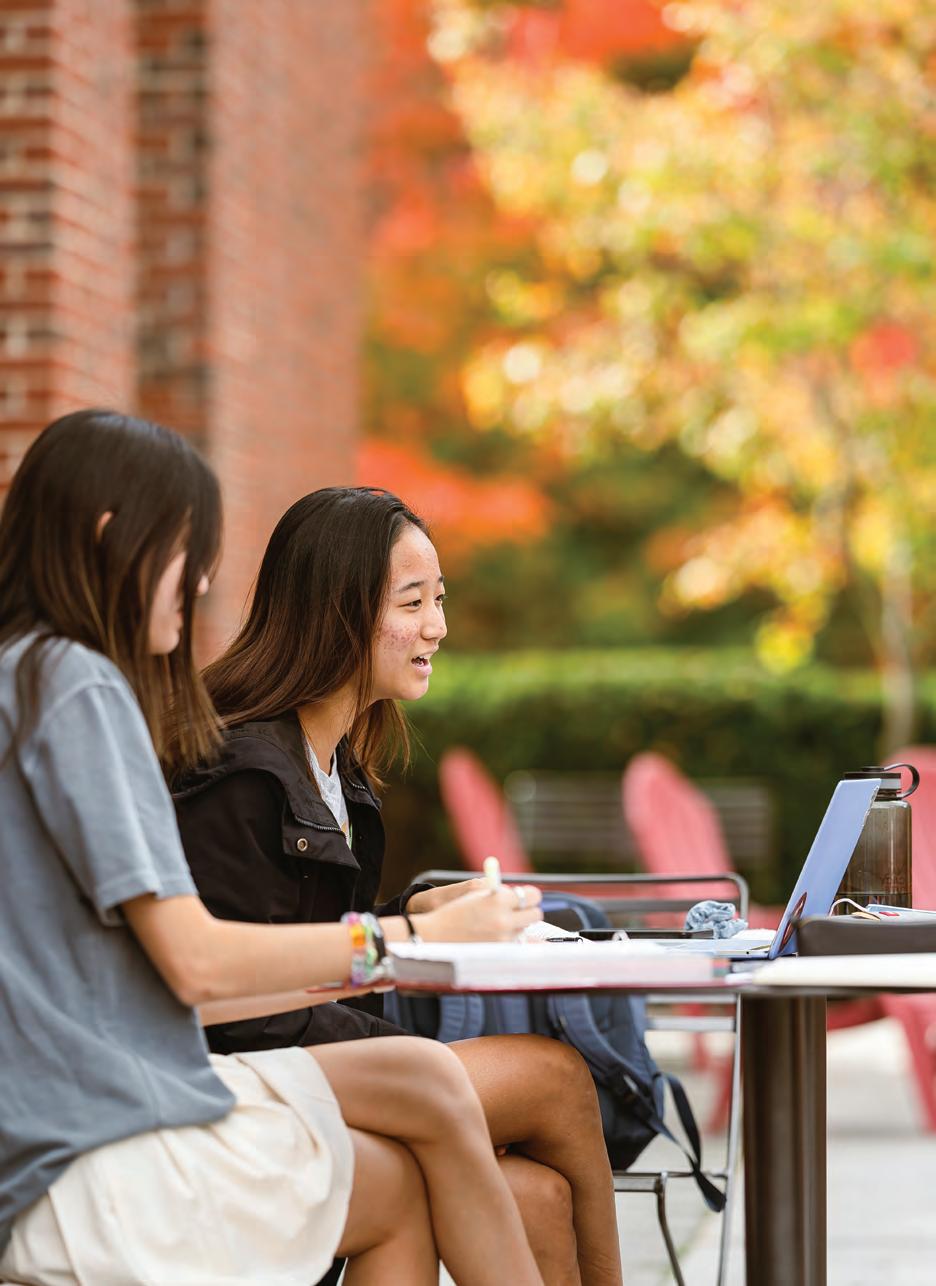
Communications may be addressed to the editor; email bulletin@exeter.edu.
Copyright 2022 by the Trustees of Phillips Exeter Academy.
ISSN-0195-0207
Postmasters:
Send address changes to: Phillips Exeter Academy Records O ice
20 Main Street Exeter, NH 03833-2460
—page 24

“I HOPE TO USE WHAT I EXPLORE IN PHYSICS AND ENGINEERING AND COMPUTER SCIENCE TO MAKE SURE WE HAVE A VERY ETHICAL WAY OF LIVING.”

24
Find
By Sarah ZobelResidential
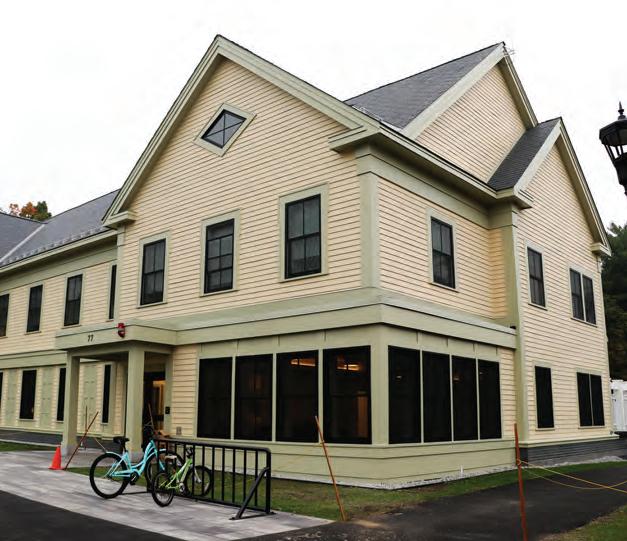 By Sarah Pruitt ’95
By Sarah Pruitt ’95
John
By
Ralph Sneeden ’98, ’03 (Hon.)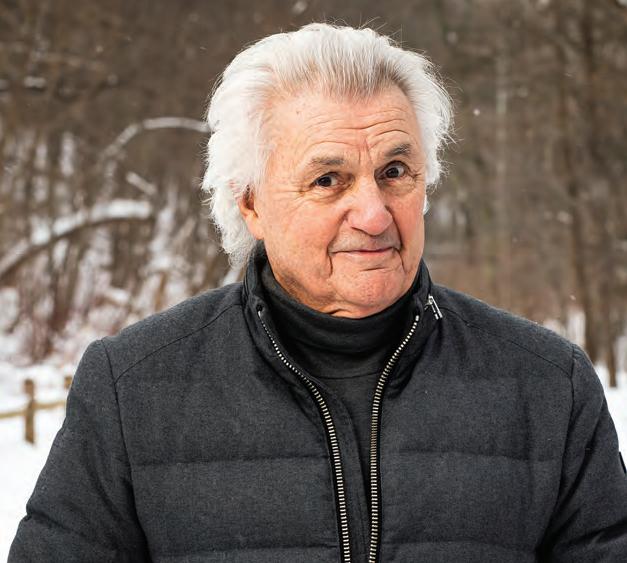
 We are E-X-E-T-E-R! Boys soccer dominates the turf in Phelps Stadium while girls field hockey thrills on Hatch Field during “Friday Night Lights” games October 7.
PHOTOGRAPH BY CHRISTIAN HARRISON
We are E-X-E-T-E-R! Boys soccer dominates the turf in Phelps Stadium while girls field hockey thrills on Hatch Field during “Friday Night Lights” games October 7.
PHOTOGRAPH BY CHRISTIAN HARRISON

I just had to write to Exeter about the cover of the Summer 2022 Bulletin. What a wonderful snapshot. I appreciate that picture and how I still relate to that boy’s wonderful smile, even after 69 years! Exeter was such a wonderful, though academically di cult, experience for me.
 Doug Halsted ’53
Doug Halsted ’53
I compliment you for the best Bulletin for Summer 2022. Read it front to back. Enjoyed three days in Exeter in May for our 65th reunion — the only disappointment was that we couldn’t visit classrooms. Keep up the great work!
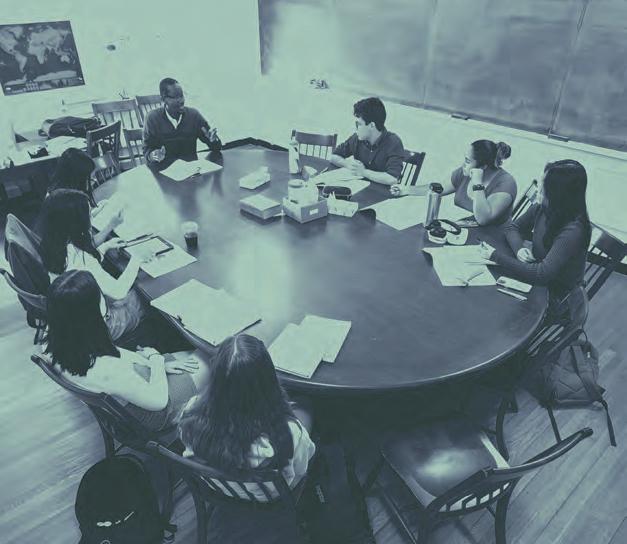 Dave Whittemore ’57
Dave Whittemore ’57
I was sad to read about the death of [Classical Languages Instructor] Allan Wooley. He was hugely in uential for me at Exeter, and I think of him regularly. I came to Exeter in January 1970 as a midyear prep admission. Mr. Wooley was the rst person my mother and I met when she was dropping me o . He was my faculty adviser in Wheelwright. In our rst meeting he emphasized that Exeter is an academic institution not a sports school; I hadn’t discussed sports with him, though I was a competitive swimmer.
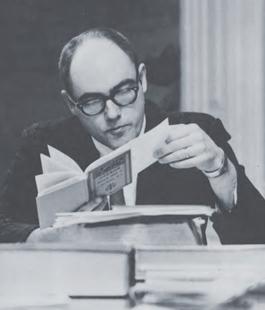
One thing we didn’t share was a love of Latin. I hated it. And I was bad at it, so every homework assignment was torture. In the spring of my sophomore year, after a year and a half of misery, I was able to get my grade up to a B-. When I met with him, he congratulated me and told me that he was placing me in honors for next year. I was dumbfounded. It was not anything I wanted or was interested in, but I did it. Mr. Wooley seemed to believe that most of life’s problems could be solved by aiming high and working harder but leavened with a sense of humor.
He was also an assistant water polo coach. One day during a scrimmage he kept calling fouls on me, even when there were obviously no fouls. I spoke to him after the scrimmage, and he explained that he was preparing me to
handle “bad calls.” I will never forget Allan Wooley. He cared for me, and believed that I could succeed in anything, including Latin, including overcoming bad calls. He was a true mentor, one of the best teachers I have ever been blessed to know.
Jim Clarke ’73Thank you for the excellent piece on, as the subtitle has it, “The Epic Story of the History 333 Term Paper.” I’m afraid there must be an error in the fascinating sidebar entitled “The Negley Prize Explained,” which writes that the rst Negley Prize went to Stewart Brand ’56. He cannot have been the rst. The Negley Prizes for the best term papers in History 4 (as it was in Brand’s day, and mine) were awarded in 1952 — four years earlier — to three seniors in the Class of 1952: Datus Proper, Charlie Montgomery and myself.
My History 4 paper is in storage, unfortunately, and I do not recall its title, but it included a study of a state desegregation case and an interview with Thurgood Marshall, then chief counsel for the NAACP, at a 1952 conference at Howard University in Washington, D.C. That conference was about the strategy that eventually led to the unanimous 1954 U.S. Supreme Court decision in Brown v. Board of Education that overturned the doctrine of separate but equal accommodations announced by the court’s 1896 decision in Plessy v. Ferguson. I had a connection to Marshall, who was later a SCOTUS justice, through my senior year roommate at Exeter, Monroe Dowling ’52, who was a family friend of Marshall’s and who (I believe) once arranged for Marshall to speak at PEA.
Keith R. Johnson ’52Thank you for wonderful windows on learning at Exeter. I particularly enjoyed the article on the History 333 paper and the Negley Prize. I received one in 1951 and treasure the books I was given. I wrote my History 333 paper about Abner Kneeland, the last person in Massachusetts to be tried for blasphemy. The paper was titled “In Their God He Trusted Not.” I remember that researching the paper in the Boston Public Library, and then writing it, gave me a special sense of satisfaction. In the process I learned that writing an extended piece of prose could be a joy for me. I have been nding joy in writing ever since.
Tom Ehrlich ’52I found the Summer 2022 Bulletin especially interesting, notably for the Faculty [Memorial] Minute on my classmate Allan Wooley, whom I really got to know only much later, as a near neighbor in Vermont. I also enjoyed the article on the American history course. In my day, the course was labeled History 4, while now it is History 333, no doubt from the e ects of in ation. In any case, I found that the pains and pleasures associated with working on this assignment have not changed signi cantly. My term paper in 1953, on the conversion of Michigan Senator Arthur Vandenberg from isolationism to internationalism, was awarded the [Negley] prize.
John Denton ’54Prompted by letters questioning our assertion in the summer issue of The Exeter Bulletin that Steward Brand ’56 was the recipient of the rst Negley Prize, we revisited the Academy Library’s Archives and Special Collections and discovered that the prize was most likely rst awarded in the spring of 1948 to Alan R. Trustman ’48, N. Gair Greene ’48 and F. Garrett Shanklin ’48. We appreciate the stories that our alumni shared in correcting the record.
Thanks go to our classical scholars as well, who kindly wrote to let us know that we mistakenly identi ed Ovid as a fth-century poet. Indeed, Ovid was born circa 43 B.C. and died in the rst century, around A.D. 17. E
Then you notice a light in a neighboring dorm, and two more in the dorm next to that. You have no idea whose rooms these are, yet in that moment you imagine other students at di erent points around campus, seated at their own desks. You are not alone. They too are in the midst of that classic Exonian rite of spring: writing the U.S. history term paper commonly known as “the 333.” remember my own experience with the assignment well. As the daughter of an Exeter emeritus history instructor — my father, Bruce Pruitt, taught from 1973 to 2009 — inherited his love of the subject matter, but I also inherited his perfectionism, and the related (as now, years later, understand it) tendency to procrastinate. composed the nal draft of my 333 largely in the wee morning hours of the due date, without the help of the internet, on a clunky Toshiba laptop that was thrillingly high-tech to me at the time. The rough draft was in fact only six pages long, and I’m certain that at one point I did not believe would ever be able to get it done. Yet despite the History 333 term paper’s fearsome reputation, and despite any individual struggles, think most Exonians would agree with me: It’s that very chal- lenge — the feeling of owning your work, of pushing your limits and achieving something that once seemed impos- sible — that makes it such an enduring, and important, part of the Exeter experience.
Whilemanyhighschool history curriculums are organized around preparation for Advanced Placement exams or other standardized tests, studying history at the Academy involves little memorization of dates or battle locations or branches of royal family trees. Instead, the Harkness approach to history centers on in-depth critical reading and independent thinking, combined with classroom discussions that often draw meaningful connections between past and present. Writing is an essential part of that approach, as is giving students a solid grounding in how to do research and craft an analyt- ical argument. The 333 is the capstone assignment of the three-term U.S. history sequence, a requirement for graduation that is most often taken in a student’s upper year. In the fall term, students focus on the nation’s colonial origins up to the outbreak of the Civil War and complete a library research assignment. In the winter, they build upon that experience, learn about the period between 1861 and 1941, and write a short research paper of ve seven pages. By spring term, devoted to U.S. history after 1941, they are ready to confront the 333 — known prior to the 1986-87 school year as “the 32.” Though it is unquestionably the longest paper that most students will write during their time at the Academy, the required length of the 333 has been adjusted over the years. Currently, it is 12 to 15 pages, or approxi- mately 4,000 words, along with footnotes and a bibliog- raphy — heavy on the primary sources. “It’s become more involved,” says Bill Jordan, longtime history instructor and director of the Washington Intern Program. “The availability of sources has dramatically expanded. You used to have to go down and use the micro lm to read The New York Times and now you just press a button and you’ve got a million articles right there.” “If there’s one piece of the Exeter experience that gives students the best preparation for writing papers, it’s the 333,” says Betsy Dolan, dean of college counseling.
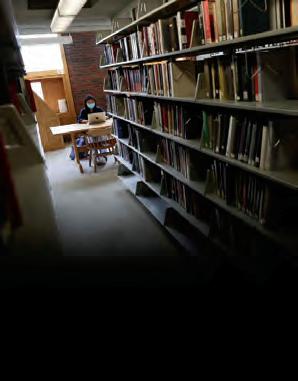
Iremember well the day I moved into Dunbar Hall as a new lower in 1968, with not much more than a single du el bag and a lacrosse stick in my hands. I had never lived away from home, so naturally I found myself wondering what the other students would be like and how I would t in. My room was sparsely furnished, and my few possessions did not do much to ll it up, nor take long to unpack. Then I was on my own.
to non-boarders, integrating them into the school more completely, including as proctors in our dorms. At Exeter, all four classes live together, and most students remain in the same dorm for their entire time at the Academy. Proctors and student listeners return to campus early each fall to be trained for their responsibilities, and the mentoring that occurs between older and younger students is important to the personal development of both. A strong sense of belonging for every student in the dorm is central to creating a strong sense of belonging to the school as a whole, and it is not surprising that our alumni typically identify rst with their class year, and second with their dorm.
This fall, we celebrate the opening of the rst new dorm on campus since 1969. It’s a multipurpose building that houses 60 students and ve resident faculty, as well as an academic space with four Harkness classrooms and a department meeting room for our Health and Human Development Department. The building also frames a spacious lawn with two other dorms, creating an exciting new community space on campus.
I could not have been happier. I was at Exeter. Friendships quickly formed, and with the support of the proctors and faculty who lived there, Dunbar soon became my home away from home. Sure, the seniors looked impossibly old to me, and I wasn’t ready to join the erce four square battles that played out in front of the dorm each evening, but I found my friends among the other new lowers, and felt that I could not have been assigned to a better dorm. In fact, like most students, I was certain I was in the best dorm on campus. Fast-forward 50-plus years, and I now have the privilege of doing dorm duty in Wentworth Hall, and the pleasure of seeing rsthand how the important work of faculty, proctors and student listeners continues to foster community today. The day student a liate program extends this sense of dorm pride and belonging

To ensure the best possible residential experience for our students, and to attract and retain the nest faculty, it is essential that we continually renovate our dorms in line with the latest principles of accessibility and sustainable construction. Out tted with geothermal heating and cooling, the new dorm is a testament to that commitment. It will be used to house students from Merrill and Langdell Halls as we embark on the renewal of those historic dorms and the construction of an expansive new dining complex on the site of Wetherell Dining Hall.
In the opening paragraph of our Deed of Gift, John and Elizabeth Phillips expressed their belief that “the time of youth is the important period.” Indeed, it is a time to learn about one’s self and develop a sense of purpose and identity, and to consider one’s place in the larger whole. Our residential programs are an essential component of this process at Exeter, and they are critical to our mission to unite goodness and knowledge and inspire youth from every quarter to lead purposeful lives. E
UNA BASAK ’90; P’19
Lexington, Massachusetts
Una Basak lived in Merrill Hall, played eld hockey and lacrosse, and volunteered for Head Start through the Exeter Student Service Organization. She holds an A.B. from Harvard College in government. Una went on to complete premedical requirements and work at the bipolar clinic at Massachusetts General Hospital. From there, she worked at The Advisory Board Company in Washington, D.C., engaging in best-practice research with health systems across the country. She now serves on the board at her sons’ school for autism, Nashoba Learning Group, and the Lurie Center for Autism at Massachusetts General Hospital. Through the Operation House Call program at The Arc of Massachusetts, Basak teaches medical students at Boston University Medical Center and Harvard Medical School about treating individuals with developmental disabilities. An elected director of the GAA since 2018, she became a GAA vice president this year.

“I am coming to this role with a deep a ection for the Academy and the recognition of a need to foster connection with our alumni of di erent a nities,” Basak says. “I hope to be able to continue the work to include and accommodate the di erences among our alumni and work with the Academy to best address the evolution of our alumni community and engage as many alums as we can in as many creative ways as we can.”
SAMUEL M. MARUCA ’73; P’04, P’07, P’10 Washington, D.C., and Vineyard Haven, Massachusetts
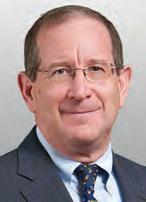
Sam Maruca entered as a prep from Lawrenceville, New Jersey, and lived in Bancroft Hall, Dunbar Hall and Lamont Hall. He was active in the glee club, orchestra, student government and basketball, and “majored” in classical languages. Maruca received a B.A. with honors in American studies from Yale College. After graduation, Sam worked for the House Administration Committee of the U.S. Congress and as a law clerk, while attending Georgetown University Law Center as an evening student. He served
on The Georgetown Law Journal sta and graduated in 1982. During a long career in private practice in Washington, D.C., Maruca specialized in large case dispute resolution in the international tax eld. He is currently senior counsel with Covington & Burling LLP and has an active pro bono practice. Maruca is the board treasurer of Capitol Hill Day School. Maruca has been an elected director of the GAA since 2018 and GAA secretary from 2020-22. He became a GAA vice president this year.
“I am thrilled and honored to have the opportunity to give back to Exeter through service on the board!” he says. “Thank you for your trust in me. I look forward to rolling up my sleeves and contributing in any modest way I can to perpetuating and improving this unique institution.”
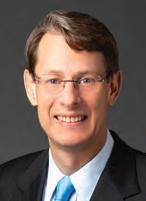
Mike Schmidtberger entered PEA in January of his prep year. He lived in Wentworth Hall; participated in cross-country, spring track and basketball; served on the Student Council; and worked in the Elm Street Dining Hall. He holds a B.A. with honors in English from Columbia College and a J.D. from Columbia University School of Law, where he served as editor-in-chief of Columbia Human Rights Law Review. Schmidtberger is the chair of the executive committee of the international law rm of Sidley Austin LLP. His principal areas of practice are securities and commodities-related funds and corporate transactions, including related regulatory matters. Schmidtberger has been on the board of directors of the United Way of New York City since 2011 and has served as co-chair since 2016. He is also a member of the Columbia College Board of Visitors, a representative to the Partnership for New York City and a trustee of the Citizens Budget Commission.
“I am honored and quite humbled to have the opportunity to serve the Academy, and all its constituencies, as a trustee,” he says. “I remember well — I was taught by an extraordinary faculty; learned from, and made lifelong friends with, fellow students; and was treated kindly by sta . I look forward to spending more time in Exeter, NH!” E
How does a library remain relevant in an internet-dependent, post-card catalog world? Laura Wood, who became director of the Class of 1945 Library this summer, thinks about that question a lot.
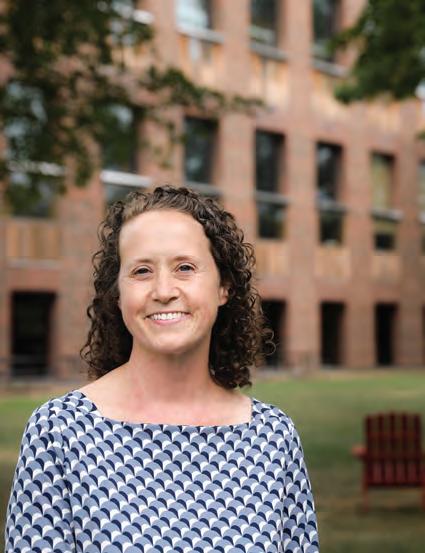
“It’s a constant learning process for me,” she says, “of how we can work with technology and with content in digital forms and maximize the library’s ability to help faculty and students as they pursue their intellectual questions and conversations — as well as assignments. My goal is to gure out how this library can continue with and increase its ability to partner with the rest of the institution, and to meet needs that maybe people haven’t even recognized yet.”
Wood is only the fth person to lead the venerable Class of 1945 Library since it opened in 1971. She succeeded Gail Scanlon, who retired in 2021. Jacquelyn H. Thomas ’45, ’62, ’69 (Hon.); P’78, P’79, P’81, who held the position for 33 years (1977-2010), had the longest tenure.
Wood discovered her passion for library studies while pursuing a master’s degree in religion from Yale Divinity School. “I came to the realization that I did not want to be a writer,” she says, “and that if I were to pursue being a professor, writing would be a major component. That got me thinking, What’s closer to what I do love? Finding information, supporting other people’s research, organizing things — the way that libraries do.”
Wood went on to earn an M.S. in information from the University of Michigan School of Information and an M.B.A. from Goizueta Business School at Emory University. After working in libraries at Emory, Harvard Divinity School and Tufts University, she most recently held the position of associate university librarian for research and education at Harvard University.
“I loved working in research universities and with librarians, but I didn’t get to work with students, and I didn’t get to participate in the life of the university in any kind of broad way,” Wood says of her decision to come to Exeter. Her view of the library’s role — and her own — ensures she will t right in.
“I think of myself as an educator,” she says, “and I was looking for an opportunity where I could better identify as a member of a community of educators.” E
FICTION
Richard Powers, The Overstory NONFICTION

Adam Grant, Think Again: The Power of Knowing What You Don’t Know

TWITTER FEED
@DuchessGoldblatt
TV SERIES
Only Murders in the Building SOUNDMAP
Sounds of the Forest
MUSIC
Yasmin Williams, Urban Driftwood
MOBILE GAME Wordle
BOARD GAME Azul

One morning in late July, a group of seventh and eighth graders enrolled in Exeter Summer’s Access Exeter program gathered on the third oor of Phelps Science Center to engage in a lively discussion — about ice cream. Their teacher, Trevor Marrero ’12, listened closely as the students discussed how middle school buddies Ben Cohen and Jerry Green eld started their eponymous brand from a storefront in Burlington, Vermont.
“They had a di erent view on how to make ice cream by combining things and making it chunkier,” one student o ered. “They wanted to conduct an experiment to see if it was possible that business could be a tool for improving quality of life for people instead of doing it for money,” another added.
With its public commitment to socially progressive values, including the use of Fair Trade Certi ed ingredients, Ben & Jerry’s was an ideal case study for Marrero’s course, Entrepreneurship: Moral Money Making.
Marrero, a newly minted graduate of the Kellogg School of Management at Northwestern University, returned to Exeter for the summer before starting his new position at Analysis Group, an economic consulting and strategy rm in Boston. An alumnus of the Access program, he jumped at the chance to spend ve weeks back on campus. “I love coming back,” he says. “It’s very nostalgic, and there are a lot of powerful memories here.”

Marrero has maintained strong connections with the Academy as an alumni interviewer, organizer of young
alumni events in Boston and co-chair of his 10th reunion, among other roles. In the fall, Marrero began serving as an appointed director of the General Alumni Association. Recalling how he relied on the advice and wisdom of dormmates and friends during his rst years at Exeter, Marrero says he always had the desire to “pay it forward” when it comes to learning. While in business school, he worked as a teaching assistant for an introductory undergraduate accounting class, and he was expecting to have to break down the concepts even more for middle schoolers. Instead, the students exceeded his expectations. “They want to be more technical,” he says, “and they want to learn about nancial analysis and accounting concepts, which is my area of expertise.”
Marrero split the ve-week course into four modules: ideation, building out a team, scaling the business and nding a way to give back. To accommodate di erent learning styles and to keep the class fresh, he used a variety of media, including articles, podcasts and YouTube videos. He also invited several Exonian entrepreneurs (see sidebar, “Visiting Alumni Entrepreneurs”) to make online presentations about their businesses.
Though Marrero knows the life-changing experience Harkness can be, he strived to make the coursework as much fun as it was challenging. It was a summer class, after all. “We’re not supposed to be crushing them with homework,” he says. “It’s more of an experience for them — a taste of Exeter’s avor.” E
ZACH ZELNER ’12
After starting a cookie delivery company from his college dorm room, Zelner went in on business ventures in technology and cannabis. His latest success, PupSocks, makes custom socks bearing the likeness of pets based on photos submitted by customers.
NICK GRAY ’12
Gray left a budding career as an aerospace engineer to pursue his entrepreneurial dreams. He now owns and operates Gray Property Group, a multifamily real estate investment, brokerage and management firm that owns more than 50 apartment units.
LUKE GRAY ’14
Nick’s brother Luke, a mechanical engineer, co-founded SOS Carbon (Sargassum Ocean Sequestration Carbon), which offers sustainable solutions for the collection and disposal of sargassum, a type of seaweed that is toxic to marine life and threatens Caribbean tourism.
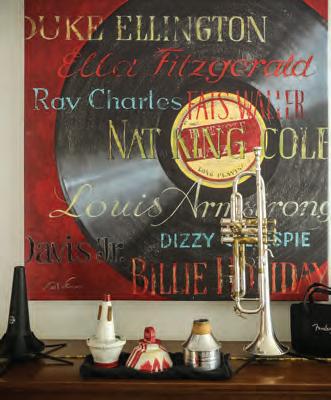 By Jennifer Wagner
By Jennifer Wagner
Raised on Baptist church music and Motown in Baltimore, Marcus Rabb brings a deep passion to his musicmaking — and to his role as a music instructor and director of bands and jazz studies, a new position that centralizes contemporary music at the Academy and expands the types of music o ered to students.
Rabb, a teacher and mentor for the past 27 years, believes in the spark a single person can be in a student’s life. For him, that individual was jazz icon Wynton Marsalis. “He is the reason I pursued a trumpet major in music,” Rabb says. When Rabb was 16, Marsalis gave a concert at his high school and Rabb performed with him. “That experience just changed my whole life.”
Rabb continued to hone his craft as a performer and composer at Howard University, where he earned his bachelor’s and master’s degrees in music. At Exeter, Rabb directs several contemporary music ensembles — including a new steel drums ensemble inspired by his time living in the Caribbean — four jazz ensembles, pep band and the concert band. He is also a co-adviser to the Exeter Association of Rock. “The music that we do is really cool,” he says. “It’s stu that’s on the radio now.” Rabb arranges all the music for the students to account for varying skill levels.

How is Rabb nding
Exonians after his rst year of teaching? “It was really a shock for me to see students that were so eager,” he says. “I’ve never had so many kids hungry to do stu . I was like, ‘Wow, I gotta keep up.’”
Here’s the score on a few notable objects in Rabb’s Forrestal-Bowld Music Center o ce.
“This painting means a lot to me because students from my first school signed it on the back,” Rabb says. “It’s got all these legendary names on it. I spent a lot of time growing up trying to emulate a lot of these people and listening to a lot of records. My favorite is Miles Davis’ Kind of Blue.”
Rabb’s original composition “A Suite for Black and Brown Heroes” was performed in February, with English Instructor Willie Perdomo’s spoken word accompaniment. “The first movement signifies that moment when you hear the call and think, OK, I’m going to have to sacrifice, I’m afraid, there’s trepidation,” Rabb says. “The second movement is the actual climb. It’s the battle, so the music changes.” Rabb hopes to complete two more movements and perform the piece during Exeter’s Martin Luther King Day celebration in 2023.

“My mom bought me this Bach Stradivarius trumpet,” Rabb says. “It was top of the line back in 1987. I’ve been playing it since I was 17 years old. We’ve been all over the world together.”
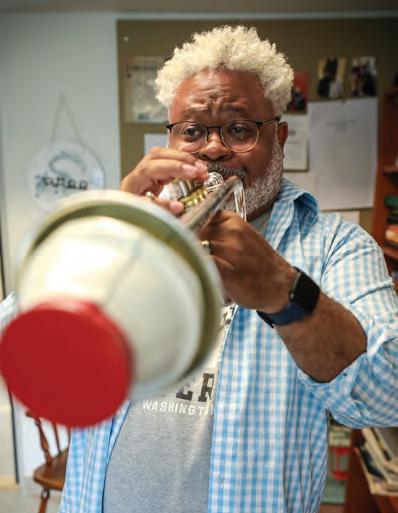

“After George Floyd was murdered I was devastated, like a lot of people,” Rabb says. To process and “express everything I was feeling,” he created this collage. “I tried to think of everybody that had been important to me that was not a musician … Malcolm X, Rosa Parks, John Lewis, Harriet Tubman, Maya Angelou, Muhammad Ali. Whenever I look at it, it makes me think about how much people have sacrificed.”


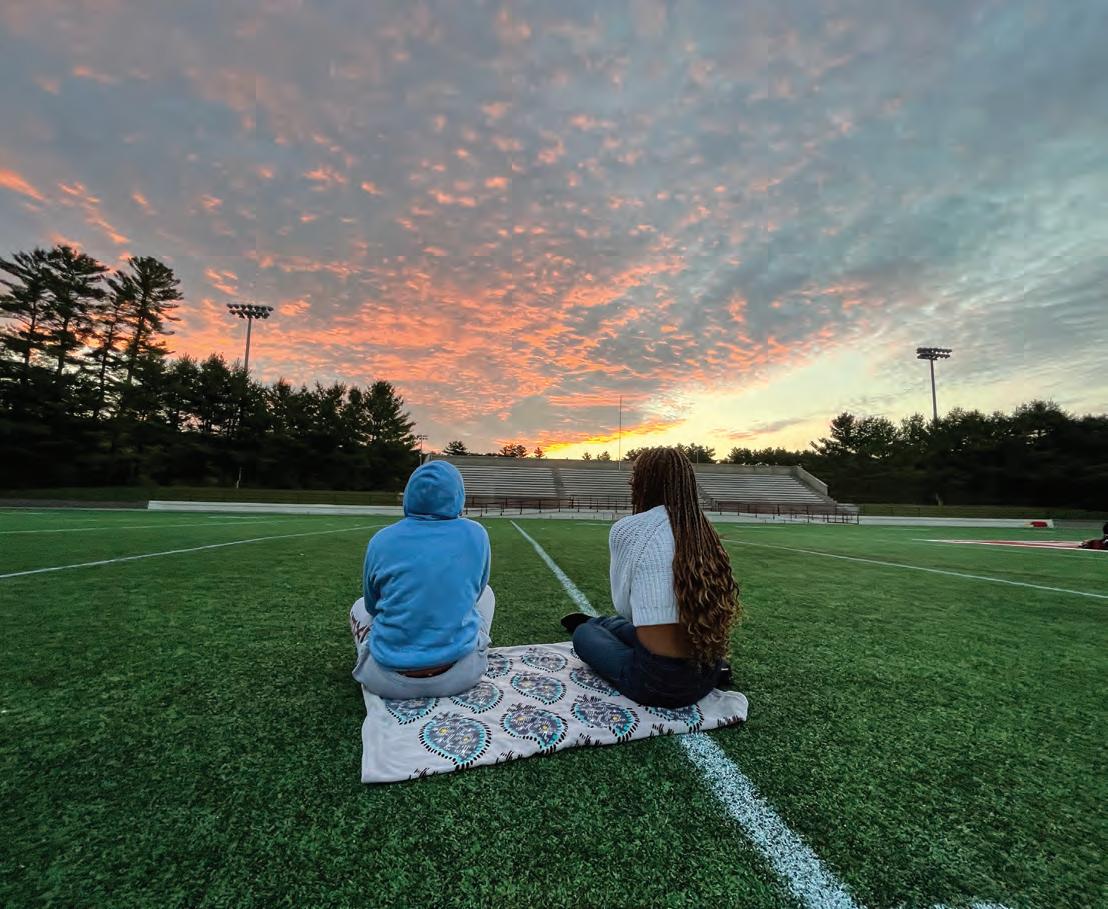
tunes and treats abound as club heads get the word out to potential new members.

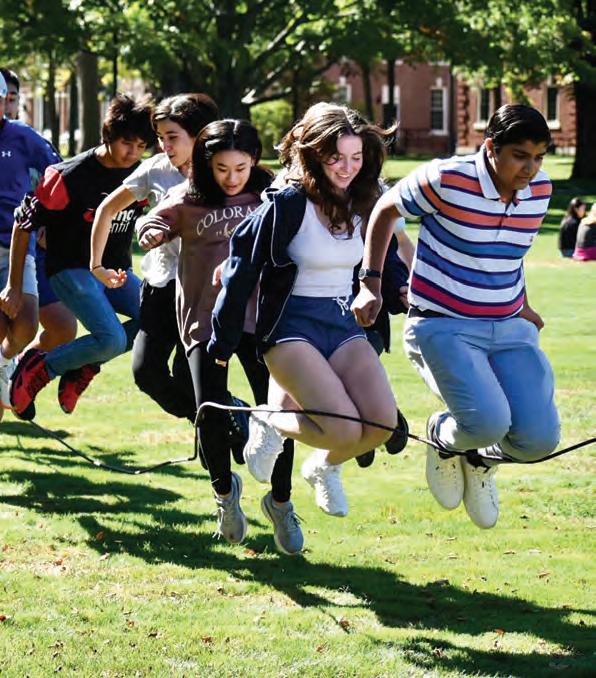

The shrill chime of my phone’s alarm lls the room. Hit “snooze” and close my eyes. Repeat this pattern for the ve other alarms I’ve set. Hopefully my next-door neighbor, Audrey, already left for class, otherwise she might wake me up with a bucket of cold water.
Get up and get ready after spending ve minutes yelling at myself for watching that extra episode of “Narcos” before bed. Still groggy. Change and put on the outft I set out yesterday. It’s only the frst week of school — I can’t already start dressing like I don’t care.
Speed-walk to the music building for jazz band. My instructor, Mr. Rabb, enjoys my jokes but not my tardiness. Sit in the trumpet section (the best section) with my senior buddy Nur Almajali ’23! #shoutout
Nur and I arrive at assembly just as it’s starting. Assembly Hall is full, so we awkwardly stand on the side until we spot some seats. Squeeze into a row packed so tightly that every time I move, I accidentally elbow the girl to my right. Sorry! Settle in and listen to Deans Weatherspoon and Cahalane go over helpful back-to-school do’s and don’ts. At one point Dean Weatherspoon breaks into song. He does this too often for me to be shocked every time.
Suddenly ravenous. I need to get to Grill ASAP. Beating the post-assembly rush will be crucial. Put my backpack on my lap and eye the closest door so my exit can be smooth.
Assembly dismissed. Luckily McConnell Hall was not among the dorms called for attendance. That’s fully my doing; I crossed my ngers and sent Dean Weatherspoon some brain signals. Make a beeline to Grill. Nearly wipe out on the Academy Building stairs.
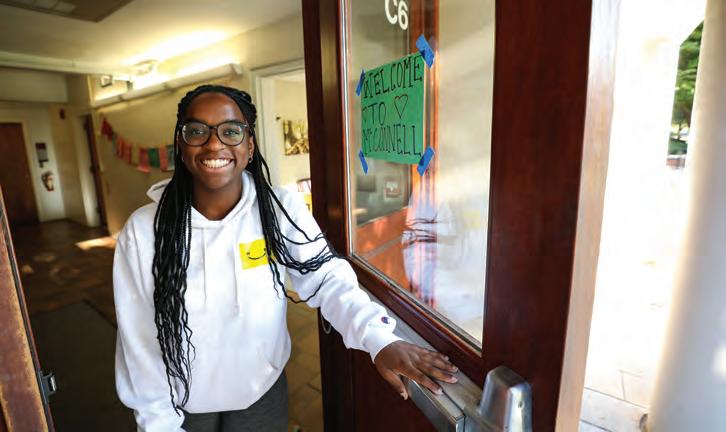
My order: tater tots and a strawberry and banana smoothie. 10/10; if you haven’t tried it, you haven’t lived.
Craving satisfed, I’m off to Spanish class with Señor Ardura! I spent a month in Spain this past summer for study abroad, so I’m waiting to wake up and suddenly be fuent. Should be any day now.
English. Long block. Try to stay focused. The book of poems we are reading, Floaters, is interesting, but I want lunch.
Find my friends in a crowded Elm Street Dining Hall. Jokes are passed around the cramped table. Set to work making a sandwich, patrolling the toaster so nobody steals my bread.

Head back to McConnell to get ready for Yoga as Meditation! Thank you Mrs. Nydick for teaching the most relaxing class on campus.
Yoga. Tell myself I won’t fall asleep during our stationary practice, but always do. Speed-walk across campus to get to Phelps Science Center for physics. I’m realizing I need to start properly estimating how far away the buildings are. Climb the stairs to the third oor, ascending the length of the whale skeleton and slip into Room 310. It’s early in the term, but I have no idea what I’m doing so far.
Time to check my email. When did I get old enough that checking and responding to my emails takes a half-hour? And why do I have so many emails?
U.S. history! I won’t say anything about it — I’ll let you reminisce about your experience.
Back at the dorm. I have homework to do but rst, some mindless scrolling through social media.
Start my homework (read that in a spooky tone). Luckily tomorrow is a half day — I only have two classes. I should do some homework for Thursday, but who has time for that?
Back to Elm for dinner, praying they have roasted garlic vegetables.
No luck on the roasted garlic vegetables. But they do have soft serve, yay!
Eat and laugh with my friends again! A lot of them are coming back from sports, so they are a little wiped out. But that’s OK, everyone is feeling drained by this time. How do we have so much homework in the beginning of the school year?

Remember that I have a piano lesson tomorrow. I should get some practice in before then. Unsuccessfully try to recruit some friends to come with me.

Haven’t practiced all summer and that is obvious. Maybe it’s best that I’m here alone.
Freak out, realizing I’m going to be late to Student Council! Never mind! We haven’t started yet so my Tuesday nights remain free. Head back to the dorm and sit in the common room to do some homework so I can feel like I’m really using that extra hour well.
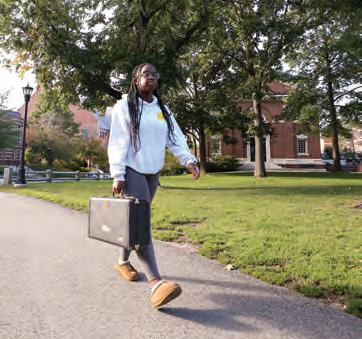
Realize I spend more time talking with Allison and Jane than working. Time to go to my room.
Check-in with Ms. Stallings! She’s new to the dorm but she’s been seeing a lot of me for physics help. Thank you, my physics angel!
Learn that I passed our Tidy Tuesday check! My clothes weren’t strewn across the oor so it was a done deal.
Watch The Truman Show, a movie recommended by my adviser, Mr. Matsumaru. I’ll share my rating with him tomorrow. I have a feeling he won’t agree. Have some late-night cookies while watching cooking videos.
Goodnight! (My Wednesday schedule looks like a breeze — otherwise I would NOT be going to sleep so early.) E
Eager students gather in the doorway of Room 317 in the Phelps Science Center like anxious ski racers at a start gate. When Instructor Nico Gallo gives the OK, the Design Lab quickly lls with laptops, backpacks and conversation. It’s early in the fall term and the rhythm of EXI555: Principles of Engineering and Design is beginning to take shape.
In this integrated studies course, students explore the engineering process through a series of projects including developing hand-sketched and computer-generated designs and producing tangible objects, all while asking, “How can we design and build for a better future?”
Students assemble around a large workbench in the middle of the room as Gallo lays out the expectations for the period. Gallo’s youthful looks may have the uninitiated visitor wondering, “Who’s in charge here?” But it’s soon clear, he’s fully in control, providing guidance and instruction on the trove of tools and machinery available in the
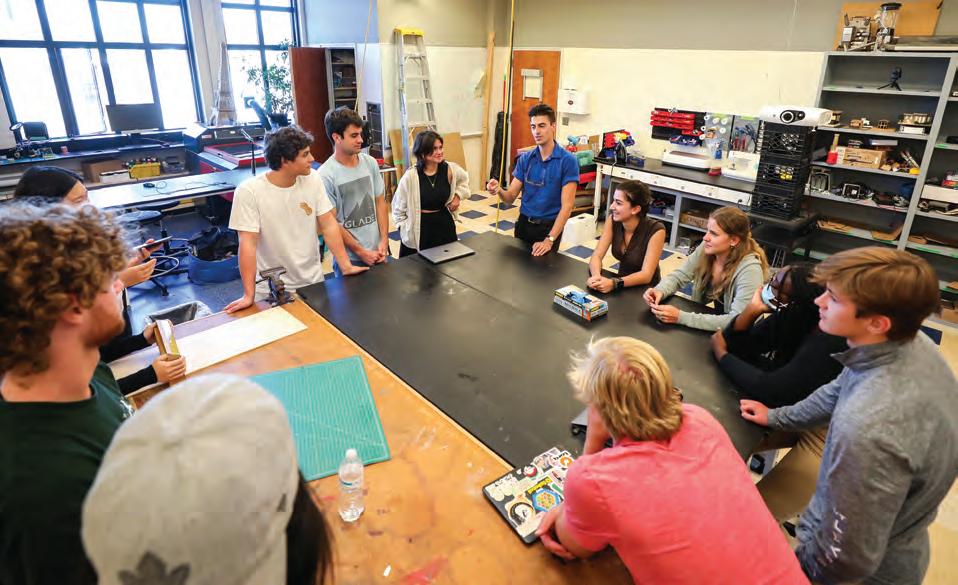
Design Lab. It’s a space Gallo, now in his sixth year as the lab’s coordinator, knows well.
The day’s lesson plan, intentionally left loose, only asks that students take their tool case prototypes and make progress toward a nished product. Gallo’s preamble serves as a pep talk to push forward, even if initial designs must be altered, it’s all part of the process. “We need to make some choices early and commit to them fast,” he says. “Build something, test it, and build the next thing. It’s not always linear. … Don’t get too stressed out but move with a sense of urgency and commit to your decisions early.”
And with that the huddle breaks and students fan out to all reaches of the room. Joey Dong ’23, Jolie Ng ’23 and Casey Realini ’23 start at the laser cutter. The instrument will be in high demand throughout the period. Being rst means they’ll have time to work out the kinks. The students place a three-foot piece of birch wood into the
machine and move to the computer to pull up their design in Adobe Illustrator. Dialing in the intensity of the laser proves to be dicult and the group works through a series of test cuts with varying success as the smell of burnt wood lls the room.
While the troubleshooting at the laser cutter continues, Gallo gives Rianna Skaggs ’23 and Nana McBrown ’23 a tutorial on the band saw. The demo focuses on how to safely make precise cuts on small pieces of material. Skaggs and McBrown take turns using scrap wood as a bu er between their ngers and the buzzing blade as they feed slivers of birch into the saw.
A loud thud comes from across the room as Jacob Jamani ’23 drops a textbook onto his prototype tool case. He’s testing the strength of small pieces of rolled cardboard he’s added to his design to prevent the case from crushing under pressure. He gives a satised nod as both the prototype and the textbook escape in one piece.
With the time in the period running low and the laser cutter still occupied, Skaggs, with her newfound con dence on the band saw, suggests the group opt for using the lower-tech option to score the sides of the tool case. Nicholas Rose ’23 steps up to the machine and in a series of quick cuts walks away with what will become the frame.

Just as quickly as the period started, it’s over. Gallo has the students tidy up their workstations and, after a quick debrief, dismisses the class. Those who are able stick around for open lab hours, and the room again whirls with activity. E

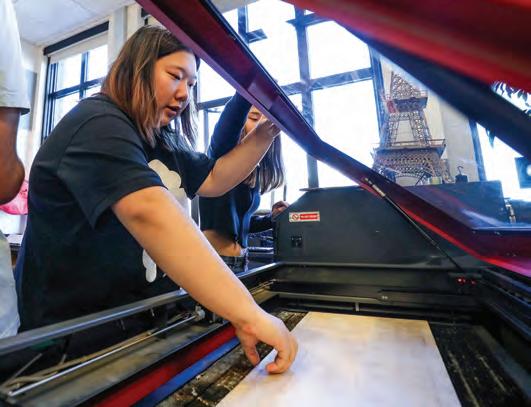
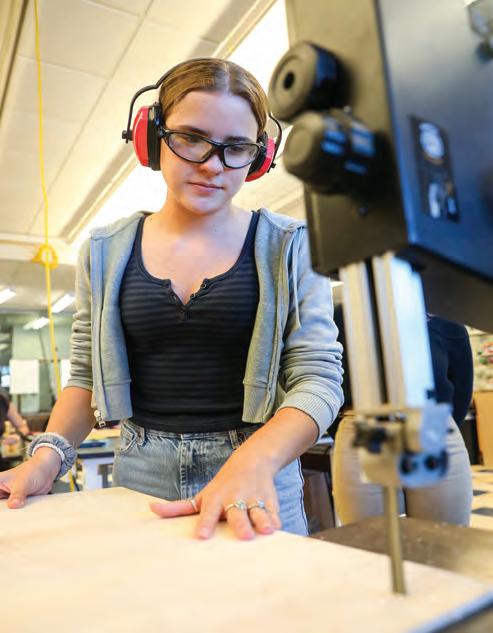
Spikeball is an amusing distraction. Cornhole is for barbecues. The gentlemen of Cilley Hall have their own game of skill and athletic prowess that has endured for decades: Cilley Ball.

The o cial sport of the boys dorm is equal parts volleyball and tennis with some custom modi cations. The court, set along the building’s north side, is split in half by two wooden benches to serve as the “net.” A game of C-Ball — as the denizens refer to it — requires two teams of two and a speci c Hedstrom ball. The current game ball is adorned with the puppies of Paw Patrol.
“We tend to pop about eight balls a year, so someone has to go and get balls every once in a while,” says Joe Doherty ’23, a dorm proctor and fouryear C-Baller.
“There are three basic rules,” Doherty says. “One, each team gets three touches. Two, each team gets one bounce. Three, if the ball hits the bench, the touches and bounces reset.”
Believed to have been invented in the 1990s and modi ed since, Cilley Ball has been a welcome diversion for hundreds of Cilley boys.
“Those forged-on-the-court friendships are worth any dip in grades,” wrote Cilley Hall resident Max de La Bruyère ’09 in The Exonian in 2008. “Something it has taken me a few years to convince my parents.” E
Alumni are encouraged to advise the Bulletin editor (bulletin@exeter.edu) of their own publications, recordings, films, etc., in any field, and those of their classmates, for inclusion in future Exonians in Review columns. Please send a review copy of your published work to the editor to be considered for an extended profile or review in future issues. Works can be sent to: Phillips Exeter Academy, The Exeter Bulletin, 20 Main Street, Exeter, NH 03833.
ALU MNI
1952 David W. Beer Pieces of the Past: A Recollection. (Lexington Avenue Books, 2021)
1955 Richard W. Bevis. The Time Machine and the Domaine: Origins and Functions of Imaginative Literature. (Friesen Press, 2022)
1958 William Weber. Canonic Repertories and the French Musical Press: Lully to Wagner. (University of Rochester Press, 2021)
1959 Wendell Arthur “Du ” Du ield. Essays, Poetry, Photographs, Song Lyrics. (Golden Publishers, 2022)
1959 G. Jordan Maclay Transformations: Poetry and Art. (Quantum Fields, 2022)
1962 Chester E. Finn Jr Assessing the Nation’s Report Card: Challenges and Choices for NAEP. (Harvard Education Press, 2022)
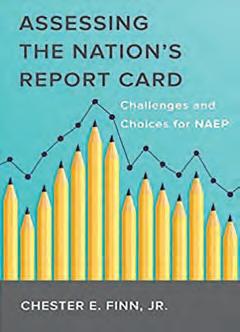
1963 Henry S. Merrill, co-author, coeditor. They Kindled a Fire: The First 50 Years of Wilderness at Earlham College. (Earlham College, 2021)
1966 Peter Thompson. Rhodes to Morocco. (Lavender Ink/Díalogos, 2022)
1968 Je rey Gould. Entre El Bosque y Los Árboles: Utopías Menores en El Salvador, Nicaragua y Uruguay. (Bielefeld University Press, 2021)
1968 Tony Seton The Ultimate App: It’s free, it’s pre-loaded, and it runs yours life (self-published, 2022)
1968 Robert Stucky What a Tangled Web We Weave. (self-published, 2021)
1972 Josh Gidding, editor. The Ways We Were: Exeter Remembered 1968-1972: Volume 1: Essays by the Exeter Class of 1972 (Exeter Class of 1972, 2022)
–The Ways We Were: Exeter Remembered 1968-1972: Volume 2: Artworks by the Exeter Class of 1972. (Exeter Class of 1972, 2022)
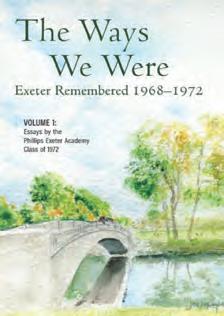
1973 Nick Trefethen. An Applied Mathematician’s Apology. (Society for Industrial and Applied Mathematics, 2022)
1976 Frank Daykin. Finding Keeping Losing Weeping: (New Poems 2020/2021). (selfpublished, 2022)
1984 Roland Tec. A Nagging Feeling Best Not Ignored, interactive play written for the Zoom platform, performed July 6-27, 2022.
1991 Noel Sloboda Creature Features, poetry chapbook. (Main Street Rag Publishing Company, 2022)
1998 Intisar Khanani A Darkness at the Door (Snowy Wings Publishing, 2022)
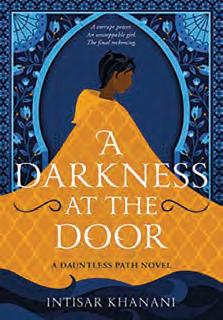
2000 Dan S. Pasternack. You’re Not Welcome Here: Exclusionary Practices in the Game of Baseball. (Barnes & Noble Press, 2022)
2003 Cecelia Baum Mandryk. Happiness Created, podcast. (iTunes, 2022)
2009 Ray Hawkins. “Step Down from the Podium: Why student-centered education is the system of the future,” article. (Independent Education, autumn 2022)
2016 Zhengyan Darius Shi. “Loop Current Fluctuations and Quantum Critical Transport,” article (arXiv, Aug. 2, 2022)
Willie Perdomo. Poetry reading at the Geraldine R. Dodge Poetry Festival, October 2022.
Thomas W. Simpson. “Dislocations,” a review of Zeina Hashem Beck’s poetry collection O. (Tar River Poetry, fall 2022)
Ralph Sneeden. “Song of the Jet” and “Fearing Street,” poems. (Book of Matches Literary Journal, Issue No. 5, May 2022)
— “Whole Lotta Love,” poem. (Cider Press Review, Vol. 24, Issue 2, June 2022)
 By Brian Muldoon
By Brian Muldoon
Building leadership, building culture and building community. These are all part of the game plan behind the Captains’ Council, an initiative implemented last fall by the Physical Education and Athletics Department. It brings together the administration and more than 70 Big Red varsity captains to discuss opportunities, challenges and ideas pertinent to Exeter teams.
“The rst year of the Captains’ Council was a great way for us to get to know our leaders at a deeper level, have a two-way sharing of information and get the pulse of the student-athlete experience,” Director of Physical Education and Athletics Jason Baseden says. “The council is a place for students to talk to us about their experience and set the standard for what they want their experience as Exonians to be.”

This year, the council members joined proctors, student listeners and other student leaders on campus prior to the o cial move-in day to take part in leadership training workshops.
The Physical Education and Athletics Department also partnered with P/ATH, Progress Through Athletics, to further educate our students, coaches and the department on building a safe, equitable, inclusive and winning culture.
“P/ATH has invaluable tools and lessons that hit home to leaders in sports across all levels, high school through professional,” Baseden says, noting that the P/ATH curriculum touches on topics such as building con dence, identity, empowerment and being a great teammate. “We want our athletes to set the objectives they have culturally, in the greater community, on their teams and on the eld and have us, as the adults, give them the tools they need to reach their goals.” E
DIANA DAVIS ’03
Girls Varsity Cross-Country
Davis takes over as head coach of the girls cross-country program, succeeding Gwyn Coogan ’83, who led the program for 17 years. As a student, Davis was a former captain of the girls cross-country, winter track and spring track teams. Coincidentally, she is the third member of Exeter’s Math Department to also serve as the head cross-country coach, following Coogan and Rick Parris, who led the squad for 27 years. Davis, who once ran at least two miles every day for over six years, competed for Williams College and has been an assistant coach with Exeter’s program since 2020.
LOVEY ROUNDTREE OLIFF
Director of Tennis and Squash
In this role, Oli oversees all operations of Big Red’s six interscholastic tennis teams and four squash teams. Oli has served as the girls JV tennis coach for the last two years and as the girls squash coach since 2019. As a former classroom teacher and lifelong athlete, she brings to the teams her knowledge of physical and mental preparation, e ective team dynamics, and the importance of balance between athletics and the Harkness pedagogy. Oli is still active in both sports, competing in various United States Tennis Association and US Squash leagues.

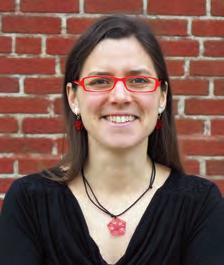 — Brian Muldoon
— Brian Muldoon
Paddleboard for credit? Sign me up! This fall, the Physical Education and Athletics Department rolled out a new course, PEC150: Outdoor Challenge, in which students canoe, hike, cycle and, yes, paddle, their way through the term. The experiential curriculum — which takes advantage of Exeter’s nearby natural wonders including the Academy Woodlands and the Squamscott River — also teaches camping skills, outdoor survival and, of course, how to have good old-fashioned fun.
“Students come to class with all the burdens of the day and leave rejuvenated,” says Physical Education and Athletics Instructor Kerry McBrearty. “It’s amazing what nature can do.”

Big Red ace James Clavel ’23 rst played baseball in Japan, where he lived from age 8 to 12, so it was tting that he returned there this summer as an intern with a professional team. Thanks to his Japanese maternal grandmother and family trips to Japan every summer until COVID hit, Clavel has stayed uent in the language and interested in the culture. Through some local contacts, he secured an internship with the Fukuoka SoftBank Hawks, a member of Nippon Professional Baseball.
Clavel spent three weeks conducting statistical analyses for the team, which has won 11 championships. “They liked me because I understood both U.S. and Japanese baseball,” Clavel says.
His primary focus was on trends among American batters in Japan, analyzing what made some more successful there. He looked at walk rates and noted that the higher the rate, the more successful the Americans were in Japan. Interestingly, he also determined that players who tend to strike out in American baseball, where success is measured in home runs, did well in Japanese baseball, where the game is less focused on power.
The internship reinforced Clavel’s plans to make a career of scouting or other o -the- eld work in baseball.
JAMES CLAVEL ’23And though he would have welcomed the opportunity to throw a few pitches, Clavel was happy to spend time focusing on a sport he loves in a country that means so much to him.
“I was really interested in working with a baseball team; I would’ve done anything,” he says, acknowledging that he did some homework on stats and Excel spreadsheets before heading to Japan. “Once I got there, they showed me a lot of it’s just using your eyes and looking for trends.” He also used his eyes and his expertise to scout high school and industrial league tournaments in Osaka, tracking pitchers with video and a radar gun. At least two of those pitchers are likely to be drafted this winter.

With a population of 1.5 million, Fukuoka, in southern Japan, is not a small city, but Clavel, who lived there on his own, was noticed enough to be interviewed on national television.
“I guess it was a bit of a novelty to have an American person there,” he says. “My boss told me they thought it was really interesting that there was a foreigner who was working in baseball.”
For many Exonians, the summer months o er that rare opportunity to follow their passions unhampered by schoolyear schedules and commitments. We caught up with four seniors as they settled on campus this fall and asked the time-honored question: How did you spend your summer?
Insomnia keeps Minseo Kim ’23 up at night, but she is sleeping ne. “I would start in the afternoon and just keep coding and xing bugs,” she says. “Night would pass by and before I knew it, my mom would knock on the door and bring me green tea.” That coding was integral to DreamCatcher, a product Kim is co-developing that uses photoplethysmogram (PPG) data to track sleep.
Early in the pandemic, while attending classes from her home in Seongnam, South Korea, Kim became aware that her fellow Exonians and millions globally were struggling to get a good night’s sleep. With tech and design thinking in her blood — she has lived in tech hubs Silicon Valley and Seattle — Kim and a teammate began exploring a new way for people and their doctors to track sleep data as part of the POSCO ICT AI Youth Challenge.
Sleep is routinely monitored with an electrocardiogram (ECG), which tracks heart rate, heart rate variability and other health data. But it requires the user to wear multiple sensors that can make it di cult to sleep. A PPG, however, requires only a single sensor — think Apple watches and oximeters — though the data it provides aren’t as detailed. Using arti cial intelligence, Kim and her teammate were able to “train the model” to estimate an ECG wave accurately from a PPG wave and provide detailed data on how well and how long the user slept.
They encapsulated the circuitry in a forehead sensor Kim designed using Blender, a computer-aided design program, and produced with a 3D printer. Through Bluetooth and an Android app the teammates developed, the sensor could submit data to the user’s phone. The app
also could provide pink noise, a blend of sounds that have been proved to aid with sleep. Research shows that background sounds can be disruptive during deep sleep, so the sensor could deliver a signal to the app to turn o the sounds when the user enters rapid eye movement (REM) sleep, the deepest stage.
The resulting paper received a Samsung Humantech Paper Award competition bronze medal in February 2022. Kim and her collaborator have a patent pending on the hybrid AI architecture they developed, a generative adversarial network and a convolutional neural network.
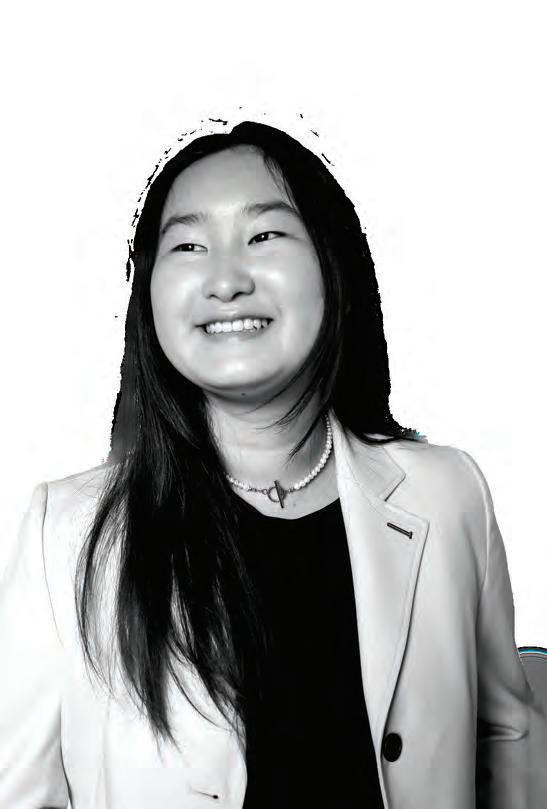
DreamCatcher isn’t Kim’s rst use of AI and technology to respond to a health concern. In middle school, alarmed by the increase in suicide rates among her peers due to overwhelming academic stress, she developed a “mind lightening pen.” A combination of programming and heartbeat sensors that responds to an increase in stress level, the pen buzzes to remind the user to take a break from studying.
This summer, in addition to re ning the DreamCatcher, Kim volunteered as chief technology o cer for the South Korean branch of United Nations Volunteers and was an intern at the Way Maker School in Seongnam, helping to build a computer science curriculum that includes AI, emotion classi cation and empathy. “That got me thinking a lot about what it really means to care for someone else,” she says. “What does it mean to be non sibi? And what does it mean to incorporate that into technology? It’s about fully understanding the person and the problem, and nding the solution together.”
By fourth grade, Isabella Vesely ’23 was focused on science. The Wisconsinite started robotics teams and later “stumbled upon” weekly lectures at the local university’s planetarium, where she took notes eagerly, surrounded by college students. By the end of middle school, she was two years ahead of her class in math, and a teacher recommended that she apply to Exeter.
Delighted as a prep to be able to choose classes in any branch of science, Vesely quickly realized her favorite was physics, for its expansive focus on everything, including particles and galaxy clusters. She barreled through Exeter’s entire physics curriculum. “Physics really helped me have this analytical mind, always questioning.”
This summer, Vesely participated in the QuarkNet Summer Research Program, a paid virtual opportunity for high school students. It is supported by the Fermi National Accelerator Laboratory, or Fermilab, which is funded by the U.S. Department of Energy and is home to the world’s second-largest particle accelerator.

Vesely and a partner were assigned to imaging galaxy clusters across millimeter, optical and X-ray wavelength bands. Those were combined with the rest of their research group’s ndings to create hyperfast, analytic
model-based simulations of galaxy clusters to determine their mass through an arti cial intelligence neural network. That kind of information, Vesely says, along with research in dark matter and dark energy, will someday play a role in developing as-yet-unrealized uses here on Earth.
“The base of physics is really just asking questions about what’s going on around us,” she says. “Once you nd a discovery and know more about the world, you can have meaningful applications. The rst step is experimenting and observing, using our eyes or, now in modern physics, computers, simulations, neural networks and AI.”
This fall, while continuing research for Fermilab, Vesely will tackle special types of problems in quantum mechanics and apply so-called deep neural networks and physics-informed neural networks as part of her senior project. She’ll review existing research to re-create results and hopes to help make the process more e cient.
Next spring, though, she’ll be a congressional intern. “We need better public policy that’s actually based on things that are pertinent in modern science,” Vesely says of her somewhat incongruent interests. “A lot of new public policy — in technology and energy, especially — has ties to physics and computer science. In the future, I hope to use what I explore in physics and engineering and computer science to make sure we have a very ethical way of living that’s more e cient.”
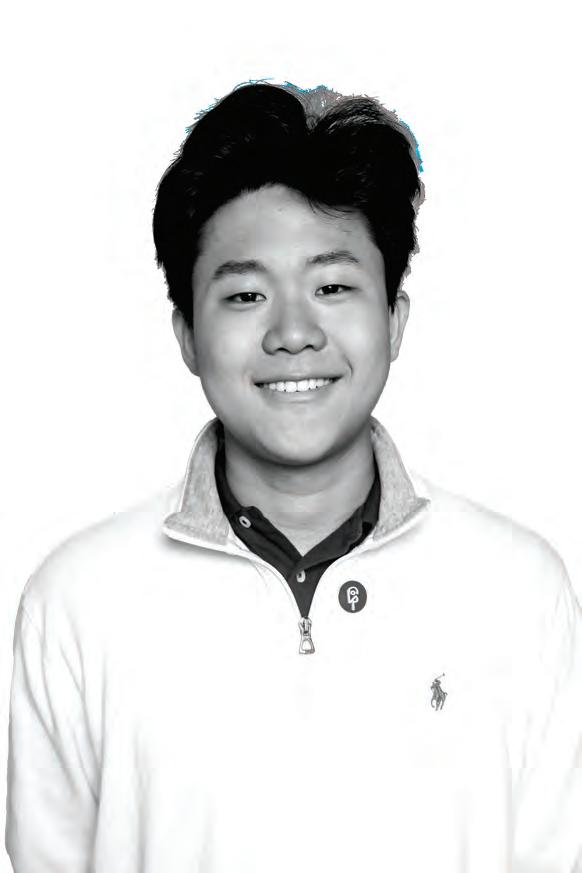
Iran might not be at the top of everyone’s travel bucket list, but for David Kim’23 it is. So, two years ago, limited by quarantine and other restrictions at home in Hong Kong during the pandemic, Kim did the next best thing to traveling: He visited the local consulate — considered “foreign soil”— with a friend. The Iranian consulate general enthusiastically welcomed his two unexpected visitors.
“That was great luck on our end in terms of meeting him rst,” Kim says. “That gave us con dence going forward.” It also inspired the two to make a formal plan to visit as many of Hong Kong’s 64 consulates general and 56 honorary consulates as they could, then share information and highlights from the ensuing discussions with their peers. The result: Consulate Review, a global organization whose mission “to bridge current and aspiring world leaders through open, meaningful conversations” is carried out today through chapters run by students in San Francisco; Cairo; Bogotá, Colombia; and Dubai, among other cities.
Together with Exeter friends Drew Smith ’23 and Jayson Tung ’23, Kim brought the project to New York and the United Nations last fall. They have met with ambassadors from every continent except Antarctica, asking challenging questions about education, gender equity, human rights, economics and climate change. They then share information with interested students through their website and Instagram feed. Kim says some conversations have been particularly notable, such as one with a member of the Israeli delegation and another with the Russian ambassador shortly before the war in Ukraine.
This summer, Kim juggled a social media internship at the Permanent Mission of the Republic of The Gambia to the United Nations with his consulate visits before returning to Hong Kong to work on rebranding Consulate Review. That meant designing a new logo and articulating objectives, but also broadening the organization’s social impact.
To that end, Consulate Review is assisting the Iranian consulate with an event introducing Hong Kong residents to Iranian culture and geography, volunteering at the Panamanian consulate’s booth at the Belt and Road Summit, and initiating a pilot program to bring diplomats to schools in New York City’s ve boroughs that might not otherwise have the means to do so. The team also hopes to begin lming informative documentaries.
“In so many di erent ways, this project entered my life and helped improve it,” Kim says, noting that the other country he would most like to visit is North Korea. “Obviously, we’re ‘on di erent sides,’” Kim, a native of South Korea, says of his meeting with the North Korean consulate general. “But once you speak with someone, if you’re kind and respectful, they usually reciprocate. That has helped me tremendously — not just in that regard, but also at school, communicating with di erent people. You should be open to conversation, open to learning somebody else’s opinion, and willing to adjust if you learn something that’s di erent from what you think but aligns with the general moral truth.” E
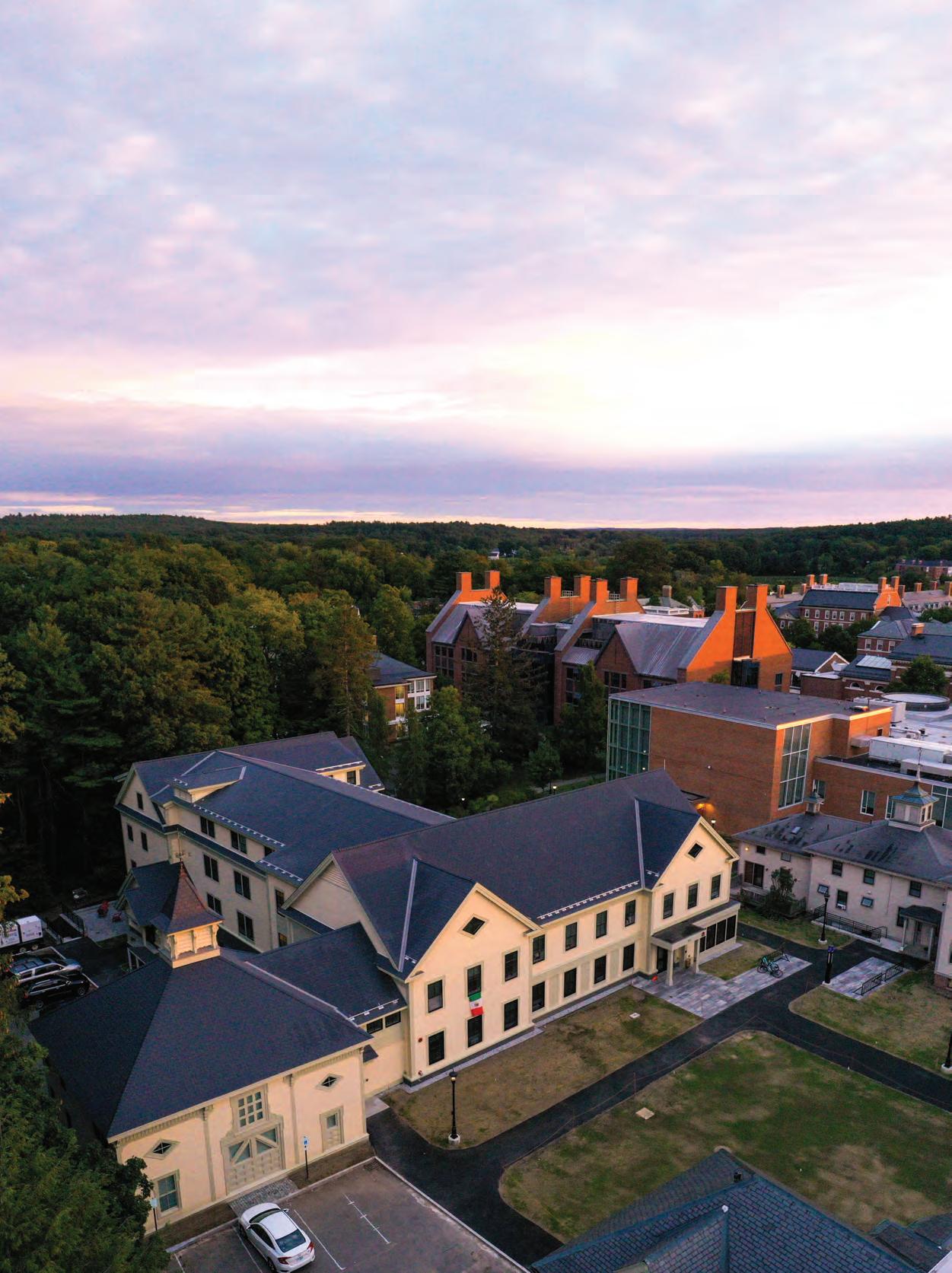 By Sarah Pruitt ’95
PHOTOGRAPHY BY CHRISTIAN HARRISON
New Hall, set upon the site of the former Fisher Theater and near the science and music centers, anchors a lively community hub on the western side of campus.
By Sarah Pruitt ’95
PHOTOGRAPHY BY CHRISTIAN HARRISON
New Hall, set upon the site of the former Fisher Theater and near the science and music centers, anchors a lively community hub on the western side of campus.
Move-in day falls on a sunny Wednesday in early September. All over campus, welcome signs decorate open dormitory doors and chalk-drawn arrows point the way inside. Students lug crates and drag suitcases along the pathways, taking frequent breaks to hug friends and compare summers.
A bit of extra excitement lls the air, along with the smell of fresh paint, as students and their families make their way down Front Street and enter the newly constructed 42,000-square-foot dormitory, currently known as New Hall. Resident faculty members perched on red Adirondack chairs greet new arrivals as they pass through the window-lined entrance and step tentatively into the dorm’s light- lled common room, where proctors have gathered to answer any questions.
In a third- oor room, Kendra Wang ’25 unpacks while her roommate, Jackie Addo ’25, has most of her belongings neatly arranged on her side of the room. The cozy double is made roomier by built-in wooden desks and shelves set against the window and dressers tucked underneath raised beds. Tackboard covers the wall above each bed, awaiting each student’s personalized array of fairy lights, posters, photographs and other decorations.
New Hall is the rst dormitory to be built on Exeter’s campus in more than 50 years. If that isn’t signi cant enough, the sustainably constructed building also houses an academic space with four Harkness classrooms, bringing living and learning at Exeter together under one roof for the rst time. With its opening this fall, New Hall has created a vibrant community hub on the western edge of campus, furthering the school’s vision of residential life as an essential part of the Exeter experience.
“There’s something really unique that boarding schools can o er to both day and boarding students,” says Carol Cahalane, the Academy’s dean of residential life since 2018. “It’s the opportunity to have many places and ways to gather with peers who are equally interested in connecting and learning about each other and the world together.”
Cahalane is far from the rst school leader to place residential life among the most valuable aspects of an Exeter education. The process of converting the Academy to a residential school goes back to the construction of the rst permanent dormitory on campus, Abbot Hall, in 1855 (see sidebar, “Abbot Hall”). In the early 1930s, Edward Harkness’ revolutionary gift funded the addition of Bancroft, Langdell, Merrill and Wheelwright Halls. This brought the school’s total to 13 large dormitories, each housing 35 to 70 students, in addition to eight smaller house dorms, and provided accommodations for instructors with families for the rst time.
“The residential element is at the heart of the education we provide,” Principal Richard W. Day reported to the Trustees in 1971, two years after the last two large residence halls to be built, Main Street Dormitory and Ewald Dormitory, opened on the northern edge of campus. “Dormitory life is not separate from but an extension of what takes place in the classroom. The value of each experience is dependent upon the quality of both.”
This symbiotic relationship was on everyone’s mind in 2019-20, when more than 700 community members weighed in on a vision for Exeter’s future and composed a Campus Master Plan. Based on the result of a student housing study, the plan included the renovation of six existing dorms over the next decade, as well as the construction of a new residence hall to house 60 students. This new hall would allow for renovation of existing dorms without either executing that renovation completely in the summers or displacing students during the school year.
“The new dormitory is not about an expansion of student enrollment,” says Heather Taylor, campus planner and architect. “It’s about a long-term strategy to improve student life and housing options on campus.”
Following Wentworth’s renewal, Langdell and Merrill Halls are the next dorms scheduled for renovation, and students from both will be living together in New Hall for the next two years. Langdell and Merrill are expected to reopen in the 2024-25 school year along with an expansive new Wetherell Dining Complex. “We’re very fortunate in that all of these are good buildings with good bones that we will be able to renovate them for the next 100 years,” Taylor says. “My hope is that the same is true for the new dorm. You want to design a building that is timeless and functions for generations of our students.”
In accordance with the principle of environmental stewardship, a key aspect of the Campus Master Plan, the primary structure of New Hall is wood frame rather than steel, which minimizes its carbon footprint. Inside, the building maximizes natural light in both the residential and academic spaces, and geothermal heating and cooling systems provide dehumidi cation to the student rooms and air conditioning and heating to the faculty apartments and academic spaces. Faculty apartments on each level include separate studies opening directly to student hallways, ensuring a strong faculty-student connection as well as privacy for instructors and their families.
The building also incorporates the historic Dow Barn, which dates to the mid-19th century. Previously used only
for storage, the barn was adjacent to neighboring Dow House, a former clinic that the Academy purchased in 1967 to adapt into a student and faculty residence. Dow Barn’s original exposed wood beams now adorn the cathedral ceiling in a second- oor faculty apartment. The façade on the barn end of New Hall incorporates the double doors and diamond-shaped windows of the original barn, as well as the vented cupola and weather vane. The same angular windows, repeated along the rest of the building, echo the barn’s classic look and feel, creating a seamless blend of historic and modern.
“I’m proud of the many sustainable features of the new building,” says Mark Leighton, director of Facilities Management. “Especially the reuse of Dow Barn, enhanced building envelope, geothermal systems, low-maintenance materials, and e cient sizing and layouts of the student and faculty spaces.”
In addition to its main residential space — bedrooms for 60 students, ve faculty apartments, an airy front common room and ground- oor game room with kitchen and laundry — the building’s academic wing is home to the Health and Human Development Department, with four Harkness classrooms, a department room and a exible common area.
New Hall was built on the former site of Fisher Theater, which was the hub of the Academy’s performing arts o erings from 1971 until the opening of The David E. and Stacey L. Goel Center for Theater and Dance in 2018. The sloping topography of the building site allows the new dormitory to easily incorporate academic and residential space, while keeping them securely separate.
The academic entrance, on the north side of the building, opens onto a courtyard adjacent to the ForrestalBowld Music Center and is a short walk from both the Lamont Health and Wellness Center and the Phelps
WE ASKED. YOU ANSWERED. WHAT DOES DORM LIFE MEAN TO YOU?
“Bancroft is the best dorm on campus for sure. Once you pass through those doors it’s like home. There’s no better feeling than seeing familiar faces, wise seniors and newly made friends. There’s a common thread of memories for everyone in the dorm, from late-night study sessions with friends, baking cookies in the kitchen, to playing Ping-Pong or singing songs in the common room. These traditions and bonds will last way past graduation and makes me proud to call Bancroft my home.” — Aveen Burney ’25
“YOU WANT TO DESIGN A BUILDING THAT... FUNCTIONS FOR GENERATIONS.”



 Clockwise from top: Historic Dow Barn houses two of New Hall’s five faculty apartments; Priya Nwakanma ’23; the main floor common area; Nora Stahl ’25 decorating her room’s built-in desk.
PHOTOGRAPHY BY CHRISTIAN HARRISON
Clockwise from top: Historic Dow Barn houses two of New Hall’s five faculty apartments; Priya Nwakanma ’23; the main floor common area; Nora Stahl ’25 decorating her room’s built-in desk.
PHOTOGRAPHY BY CHRISTIAN HARRISON
 Students Jackie Addo ’25 and Kendra Wang ’25 are one of several cross-dorm pairings in New Hall.
PHOTOGRAPHY BY CHRISTIAN HARRISON
Students Jackie Addo ’25 and Kendra Wang ’25 are one of several cross-dorm pairings in New Hall.
PHOTOGRAPHY BY CHRISTIAN HARRISON
Science Center. On the Front Street side, a broad campus green in front of the student entrance to New Hall links the building to two smaller dorms, Dow House and Front Street Dormitory. “I love how the topography allows for two distinct entrances, both of which have strong connections to campus,” Leighton says.
While the union of Merrill and Langdell in New Hall was born of necessity, it’s also an unprecedented opportunity. For the rst time, former residents of two di erent dorms, their a liated day students, and a small group of new students have come together to create a uni ed dorm identity and forge the enduring bonds so many Exonians take away from their time on campus. “I do think each dorm has a very unique culture, and I’m fascinated to see how they mix,” says Troy Samuels, the head of New Hall and an instructor in history. “I’m excited to get to play around in terms of building community.”
While Samuels and other dorm faculty members take the lead in this process, they will rely on the support of senior proctors for the vital task of building dorm unity. Other large dorms on campus typically have six to eight student proctors, but New Hall has 10, ve from each former dorm. “At the beginning of the year, we’re going to be doing double duty,” says Bronwyn Hall ’23, a senior proctor who spent her rst three years at Exeter living in Merrill. “Two people on duty every night, one from each dorm, so that we make sure everyone gets a chance to get to know people that they don’t know, and even the proctors get to know the other dorm’s proctors.”
Hall and her fellow proctors also played a key role in helping their dormmates prepare for the transition during last spring term. Merrill and Langdell residents went through the process of room draw together and also gathered on a few more informal occasions, like toasting s’mores on Wetherell-Ford Quad. “I think they’re going to be a little cautious at rst,” Samuels says, adding that
the new dorm “has just so many wonderful spaces and wonderful opportunities for them. It’s going to be great.”
After meeting for the first time during an o -campus dinner outing at a local Thai restaurant, Addo and Wang became closer friends when they both ran winter track. As preps, Addo lived in Langdell and Wang lived in Merrill, but they decided in the spring to room together this year, becoming one of several cross-dorm pairings in New Hall.
A week after move-in day, their double looked well lived-in. They have both ordered shelves to attach to their beds for phone chargers and alarm clocks, and tacked up photographs, prints and collages over their beds. A shared built-in desk, which runs the length of the wall beneath the windows, is loaded with textbooks, laptops, Clorox wipes and other dorm room staples.
“I really like the view, especially when I’m studying,” Addo says. “When times get stressful, it’s really nice to look out at the trees.” The desk is so roomy that she has placed a second chair at the end, ideal for study sessions with a friend. Wang, a self-proclaimed “super clothes shopper,” loves the big closets.
Addo and Wang acknowledged having mixed feelings over the summer about the move to New Hall, and they worried about missing the close-knit culture of their former dorms. Now, however, they are optimistic.
“There was a lot of emphasis in the rst dorm meeting of everyone really trying to make the e ort to see us as one big dorm,” Wang says. “I think that’s actually going really well.”
Addo agreed, saying: “There are a lot of people from Merrill that I wanted to talk to — people in leadership roles or people that play on the volleyball team — but never really got to know. I’m still working on that since it’s only been a week. But I feel really close with the Merrill people, and I’m really excited to see what we can do as one dorm.”
“The first thing that comes to mind when I think of Dvnbar [aka Dunbar] is family. Dvnbar has given me a family in every sense of the word, from late-night baking in the kitchen to common room chats that go on for hours (even when I still have homework). It’s a favorite proctor leaving flowers outside your door the morning of the SAT and deliriously editing your 333 in the common room surrounded by friends. It’s book recommendations from dorm faculty and helping seniors into their prom dresses. It’s the night when I walked downstairs with a cup of tea and realized that I was exactly where I belonged. Dvnbar is a place that I have poured love into and that has loved me back.” — Riley
Jones ’23THE ACADEMY OVER TIME
1855
TOTAL ENROLLMENT 116 DORMITORIES 1 ANNUAL TUITION ( BOARDING STUDENTS ) $20 2022 TOTAL ENROLLMENT
1,082 DORMITORIES 26 ANNUAL TUITION ( BOARDING STUDENTS ) $61,121
For nearly 75 years, the Academy operated without dormitories. Instead, “the boys boarded about town,” as one Exeter historian writes. But as enrollment grew, along with the cost of living, the Trustees recognized the need to o er on-campus housing to help ensure equal opportunity for all students. Charles H. Bell explains this thinking in his 1883 book Phillips Exeter Academy in New Hampshire: A Historical Sketch, writing that the Trustees “determined to establish at the charge of the Academy, a dormitory and commons hall for the members of the school of limited means, by which the expense of living should be reduced to the minimum.”
The school experimented rst with housing students in an Academy-owned building on Spring Street, which had been the J. & B. Williams printing shop. The arrangement worked so well that in September 1852 the Trustees voted “to erect a more suitable and capacious building for the same purpose, in the Academy grounds,” Bell writes. “It opened for use in 1855. It was constructed of brick, and contained rooms for fty young men, with a dining hall and other needful accommodations; and cost about twenty thousand dollars.”
As Frank H. Cunningham details in his book Familiar Sketches of The Phillips Exeter Academy and Surroundings, the rooms were “furnished at a nominal rent, so that fty boys are thus supported at about one half the cost of living at the ordinary boarding houses.” Residents paid $1 a year for a room. “The Trustees believe that no other institution of the kind in the country has approached this Academy in giving substantial aid to young men of poverty and merit,” Cunningham writes.
The building was named Abbot Hall, in honor of Benjamin Abbot, the Academy’s second principal, who served from 1788 to 1838. Abbot was a respected and beloved instructor, teaching such subjects as Latin and Greek for 44 years and counting among his pupils statesman Daniel Webster.
Ever considerate of the Academy’s mission to educate students in goodness and knowledge, the Trustees voted to post, inside each student’s Abbot Hall door, a set of eight rules, including: “There shall not be in or about the building, during study hours, any singing or playing of musical instruments, or any other noise inconsistent with the quiet study; and good order shall be preserved at all times.”
Abbot Hall remained the only on-campus dormitory until Soule Hall was built in 1893.
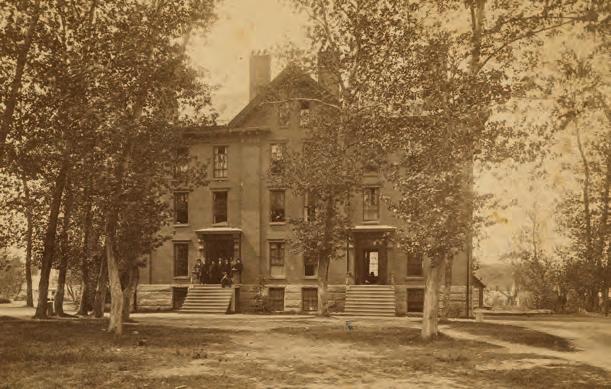
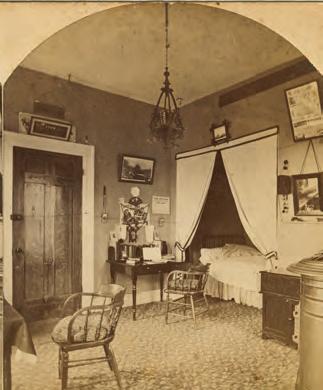
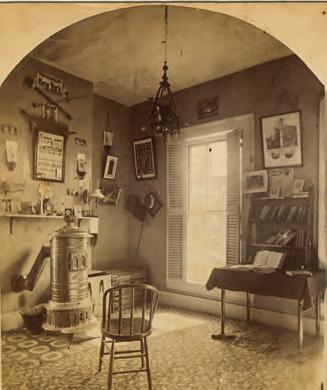 Abbot Hall, circa 1885; Abbot Hall Room 13, 1879
Abbot Hall, circa 1885; Abbot Hall Room 13, 1879
To accommodate its expanding academic curriculum, as well as the Academy’s commitment to promoting students’ physical, mental and emotional wellness, Exeter’s Health and Human Development Department has moved into a spacious new home on the lower level of New Hall.
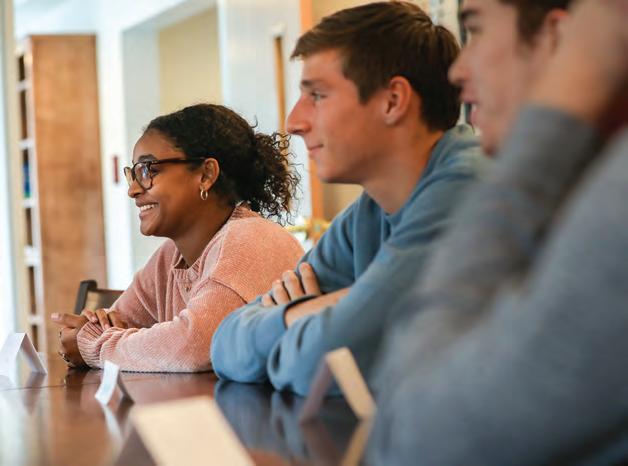

New Hall’s academic space features four Harkness classrooms, a departmental o ce and a exible lobby that can be used for group activities such as yoga, meditation and cooking, or just relaxing and connecting when not in class. Bookshelves lining the walls are home to an expanded library of health- and wellness-related books that students can browse and borrow.
While living and learning will be kept securely separate — dorm residents will have to exit the building to access the academic space — every Exeter student will have the opportunity to take classes in New Hall. “It used to be that only ninth graders and new 10th graders took health,” Department Chair Michelle Soucy says. “Right before the pandemic, we changed it, and now students from all four years take at least one class in Health and Human Development.”
In addition to introductory courses aimed at helping all new students acclimate to the school, the Health and Human Development curriculum includes a Teen Health course for each class year, including one designed to help prepare seniors for life beyond Exeter. “We cover nances, learning to cook for yourself, and a bunch of other stu for what we call the emerging adult phase of life,” Soucy says.
In the courtyard outside the building’s entrance, a circular medallion with the words “youth from every quarter” and an engraving of a lion rampant adorn a stone wall. An anonymous donor intended the medallion, and a soon-tobe-installed stone bench, to serve as a corner of campus dedicated to wellness re ection. The new feature complements one of the department’s long-running fall programs, a positive psychology fair where students gather to paint and decorate rocks with messages of positivity.
“We’re envisioning that we’ll have a little rock garden there as well,” Soucy says. “We’re always talking about the psychology of looking at things in the positive, and how you can raise your mental health.”
“I was in Dow House for one year and it was a positive, learning experience. It was the first time I had been living away from home and it allowed me to interact with a wide variety of people, both from around the country and around the world. But without a doubt the best byproduct of being in the dorms was my roommate introducing me to Bruce Springsteen and his greatest hits. Thank you, David, I appreciate it to this day!” — Alexander
Najemy ’97Ellee Dean ’01 is still settling into her home on the second oor of Exeter’s newest residence hall. “We’ve had two all-dorm meetings so far, and I think the vibe seems really playful,” she says. “The kids and adults are all talking about this being a historic moment … and a real opportunity to create something fresh.”
An instructor in English and one of ve resident faculty members taking charge of New Hall, Dean shares the apartment with her husband, Porter Hayes, a regional director of major gifts in Exeter’s O ce of Institutional Advancement; their sons Bode, 10, and Wyatt, 8; and the family’s dog, Bruno. It’s one of ve faculty residences in New Hall, including at least one on each oor of student living space. All feature hardwood oors, spacious open-plan kitchens and living areas, and air conditioning, in addition to separate faculty entrances, dedicated parking spaces and two shared patios.
“We’ve talked about how nice it’s going to be to have our dorm team meeting and sit outside,” Dean says. “I’m also so excited about the bigger common spaces for the students. … I think having that big outdoor space in front of the dorm is going to be incredible. I can already imagine the kids having picnics out there.”
Dean’s apartment, like the other faculty residences, has a study that opens directly into the student hallway. The setup is ideal for dorm duty and fosters strong ties between resident faculty and students. Dean’s study contains a table with four chairs and a roll of kraft paper mounted on the wall, perfect for students — and kids — in the mood for a writing or drawing session.
Dean has more experience than most with dorm life at Exeter. A resident of Amen Hall during her student years, she has lived in Webster Hall and Merrill Hall since joining the Academy as a faculty member in 2013. As a parent, she admits that living in a dorm has its perks. “There are always a ton of kids volunteering to babysit,” Dean says. Bode and Wyatt have also taken piano and chess lessons from student members of the Exeter Student Service Organization.
For their part, her children seem relatively unfazed by their new surroundings. Bode likes living closer to his elementary school, and to the adjacent elds where he plays baseball and lacrosse. Although Wyatt’s bedroom has a stunning view of the Academy Building’s bell tower, he’s far more excited to show o the LED lights his parents installed and his collection of Boston Celtics gear.


Wyatt does muster some enthusiasm for seeing familiar students and meeting new ones as the school year begins — particularly if those meetings involve the dorm’s basement game room. “I might play some Ping-Pong,” he says hopefully, before rushing down the hall to join his family. E

WE ASKED. YOU ANSWERED. WHAT DOES DORM LIFE MEAN TO YOU?
“Williams House was just that: a house, not a dorm. We were a family, no locked doors. French teacher Harris Thomas and his wife, Mary, were in loco parentis. Mary was the inspiration for the play Tea and Sympathy. The set for the play accurately represented the structure of the house, with the master’s residence occupying the ground floor around a grand creaking staircase that ran up from the front door. No butt room. We were a privileged few admitted to this special place. Lucky us Williams House alums.” — John Wilcox ’60

“THERE ARE ALWAYS A TON OF KIDS VOLUNTEERING TO BABYSIT.”Wyatt Hayes, Ellee Dean ’01, Bode Hayes, Porter Hayes
JOHN IRVING ’61 OPENS UP ABOUT HIS NEW NOVEL, HIS TRIBUTE TO AN EXONIAN WAR HERO, AND HIS LAST TATTOO
 By Ralph Sneeden ’98, ’03 (Hon.); P’07, P’09, P’13
By Ralph Sneeden ’98, ’03 (Hon.); P’07, P’09, P’13
In my recent correspondence with John Irving ’61 (via email and a phone call that lasted almost two hours), it was di cult separating the author from Adam Brewster, the narrator of his latest novel, The Last Chairlift. Taming this con ation, trying to keep these voices in their own corners, was harder than I thought it would be.
I was feeling like a hypocrite, too. Though I retired from Exeter’s English Department in June, I had been bludgeoning my students for decades with Vladimir Nabokov’s mantra for good readers: “We should always remember that the work of art is invariably the creation of a new world … having no obvious connection with the worlds we already know.”
Whatever you assume about skiing and ski culture, let it go when you read Chairlift. Secure your boots to your bindings and enjoy negotiating the intertwining trails of Adam’s quests. Whether he’s searching for his father’s identity, nudging into place the puzzle pieces of his skier mother’s evolving love life or his own, or brooding over the ghosts of Aspen’s Hotel Jerome, it would be a shame to project our own experience onto the narrative’s screen or try to decode the artist’s life there.

We must surrender to the story. Which is hard to do if a chunk of it is hunkered on a setting the reader knows well. Like Exeter, for instance. If you’re a devoted Irving fan and have spent time with The Cider House Rules, A Widow for One Year, The Hotel New Hampshire, The World According to Garp, the more recent Avenue of Mysteries, or any of his 14 previous novels, you might appreciate a few echoes in The Last Chairlift (e.g., wrestling!). But Irving, who turned 80 last March, is an author who can conjure a distinct world upon what we believe are the foundations of the familiar — even if we can identify the thematic and topical watermarks of his previous ctions, especially while reading the book in the very town he’s describing.
“Fiction writers like what we call truthful exaggeration. When we write about something that really happened — or almost happened, could have happened — we just enhance what happened. Essentially, the story remains real, but we make it better than it truly was, or we make it more awful — depending on our inclination.” This is the voice of writer/narrator Adam Brewster, so you get my point about authorial ambiguity, which only intensi es in the stitched together conversation that follows.
Reading this novel, just shy of 900 pages, in two and a half weeks was a full-time job, especially when anticipating dialogue with its author. I loved every word, every minute of it. Not only the gravitational pull of my empathy for Irving’s characters and being subsumed by a tangled plot and historical commentary, but its patterns and refrains, its almost Homeric epithets. Epic is not an exaggeration for the author’s heroic management of language and scope. Like Adam says, “Unrevised, real life is just a mess.”
EPIC IS NOT AN EXAGGERATION FOR THE AUTHOR’S HEROIC MANAGEMENT OF LANGUAGE AND SCOPE.”
Ralph Sneeden: Early in our correspondence, I betrayed my dread of not being able to f inish your book before our f irst phone conversation.
John Irving: What a blow it must be to your retirement — to be reading a novel longer than [Charles Dickens’] Bleak House. My Chairlift is still shorter than David Copper eld (barely). That said, it’s a relief to know that Chairlift really will be my last long novel. I know the approximate length of the boxcars in the train station, the novels not yet coupled to an engine. I’ve been trying to write the longest trains rst — either the longest or the most di cult, for reasons other than their length. It looks like shorter trains from now on. I’ve always imagined dying at my desk, midsentence. I can accept dying in my sleep, only because it would be less of a nuisance for my wife. I’m not saying I’m going to become a novella man overnight, but that’s the direction I’m going in.

You’ve written about Exeter before, sometimes in disguise, indirectly. But this novel calls Exeter by name. Did this most recent f ictional foray back to the culture of the school in the mid-20th century generate any unanticipated revelations, memories?

Nothing unanticipated. The farther I get from being the faculty brat I was lucky to be, the more free I feel to take liberties with what happened to me. The surroundings feel autobiographical, and some of the core relationships to the school are autobiographical — like the faculty-brat connection, like the townie connection. I like to use my autobiography as a stepping-o place … to make something sound grounded in the real, in the actual. Then, when the exaggerations commence, you’ll think it’s all real. What develops from these familiar circumstances never happened to me. … Sometimes I change the name of Exeter, but there’s a familiar small town and a boarding school with an insider-outsider student population.
The word “normal” and its counterparts — weird, bohemian — come up later in the novel in the context of what sort of life Adam wants to live in comparison with his experience with his immediate family.
The basic circumstance of Adam’s situation is one we’ve seen before, too — a boy with a mysterious (or elusive) mother and an unknown (or absent) biological father. This is another stepping-o place; from this familiar premise, unfamiliar things develop. Adam is the lone straight guy in a queer family; even his extended family (including Nora, his cousin) is queer. Two lesbian couples and a trans-woman stepfather are the people looking after him; they’re his support group. Adam is afraid for them. “The Honeymoon on the Cli ” could have worked as a title for the novel. Yet Adam is the one who needs looking after; he’s more badly behaved than all of them, sexually. Of course, Nora is a troublemaker, a magnet to danger, and Em (her partner) is right to see the hatred coming — to be afraid for Nora. … Adam is both the out-of-it one and the odd man out. Adam is a slow learner, the last to learn.
LGBTQIA+ themes are laced into the DNA of your work from The World According to Garp to In One Person , but now it seems the reading world might be better equipped to appreciate what you’ve been doing all along. In an email, you were passionate in your recommendation of James Hannaham’s new novel, which you reviewed for The New York Times , as a must read, because of its titular main character, Carlotta. You wrote, “It’s a time in the U.S. when state legislatures are passing anti-trans legislation — a good time to heroize a trans character!” I think Chairlift is a bold foray into that territory.
Elliot Barlow [a character in the novel] isn’t called “the only hero” for no reason; she’s a brave soul. My singling out the lonely bravery of the snowshoer owes a debt to
my trans daughter, Eva. My third son, Everett, began the transitioning process to female less than six months before I began The Last Chairlift [in 2016]. Eva read my rst draft when I’d only written half the novel. She has always been a writer — a playwright, a screenwriter and an actor. We show each other our rst drafts. She’s been doing an M.F.A. in lm and screenwriting at York University in Toronto, where she’s also had a teaching assistantship. The name she’s chosen for herself as a writer, actor, director is Eva Everett Irving, which I like, because it’s totally accurate, but I call her Eva — she’s just Eva to me. I’m very proud of her.
You seem to be working out some of the great tensions of our time through what your characters say to each other, and how your narrator processes their ideas, their opinions. Chairlift seems poignantly current even in its evocation of the 1960s, from Adam Brewster’s childhood right up to the election of Donald Trump. The novel also enables the decades of the last 70 years to have their own conversation about the events, politicians, etc., that got us to where we are now. Though your plot broaches gun violence, religion, war, the brightest spotlight is trained on gender, Roe v. Wade, AIDS, sexual orientation and, especially, Ronald Reagan.

Reagan’s moral absenteeism was most apparent in the AIDS crisis. Of the Republican justices on the U.S.
Supreme Court who voted to overturn Roe, only one of them isn’t Catholic, and he was raised Catholic; his mother was an anti-abortion activist who worked in the Reagan administration. Those justices seem more in step with the Vatican than with the First Amendment — the part that says, “make no law respecting an establishment of religion.”
In the time of the Puritans, abortion was allowed beyond the rst trimester — up to four or ve months. Our founding fathers got this right; the choice to have a child belonged to the woman who was pregnant. For more than two centuries — beginning in the 1620s in Plymouth, Massachusetts — abortion was permitted. (It was prohibited for scarcely a century.) It’s ironic that we’re a nation founded by Separatist Puritans eeing religious persecution in England. Now we’re doing the religious persecuting! An undeveloped fetus has more rights than an adult woman?
Pope Pius XII used the right-to-life term in an “Address to Midwives on the Nature of Their Profession”— a 1951 papal encyclical. Here are the pope’s exact words: “Every human being, even the child in the womb, has the right to life directly from God and not from his parents, not from any society or human authority.” The poor midwives! This amounts to mandatory childbirth. Freedom of religion is a two-way street. Yes, we’re free to practice the religion of our choice, but we’re also protected from having someone else’s religion
“DEREK O’DONNELL
THE FARTHER I GET FROM BEING THE FACULTY BRAT I WAS LUCKY TO BE, THE MORE FREE I FEEL TO TAKE LIBERTIES WITH WHAT HAPPENED TO ME.”
practiced on us. Not now — not in these United States. What Dickens wrote about the law applies to those Republican justices on the U.S. Supreme Court. “It is better to su er a great wrong than to have recourse to the much greater wrong of the law.”
In the midst of what is supposed to be my publicity and promotion for The Last Chairlift, all these years later they’re screening Cider House at the Toronto International Film Festival again. I’m introducing the screening, telling the novel-to- lm storyline — talking about the overturning of Roe, and how abortion rights were safer in 1985 (when the novel was published) than they are now. I didn’t think Roe v. Wade was safe when I wrote the novel, or when the lm was made. There’s a moment in Cider House when one of the nurses says something to Dr. Larch about the law. “The law — what has the law done for any of us here?” Larch cries. (More déjà vu.)
Let’s talk a little more about the commerce between your own life and one of the novel’s most compelling characters, Zim, based on Richard “Dick” Pershing, the grandson of John “Black Jack” Pershing, commander of the American Expeditionary Forces in World War I. Dick graduated from Exeter in 1961 and his name is on the Korea/Vietnam memorial bench at the Academy. In a novel that features a lot of ghosts, Dick’s “spirit” provides a compass bearing for your exploration of the war in Vietnam and how it affects Adam and his family. With the character of Zim, the elegiac sonar pings you’re sending out to Dick Pershing are really gorgeous, subtle.
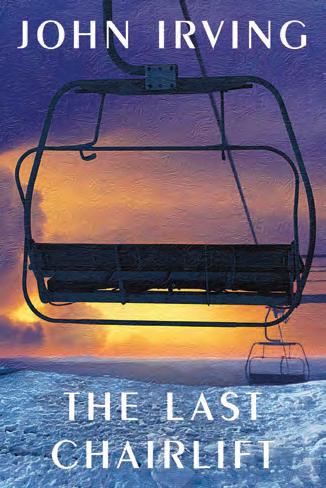
Thank you for noticing the elegiac sonar pings I am sending out to Dick Pershing — not the only friend I lost in that misbegotten war, but the one who always had a hero’s exemplary bearing. I’m a member of the class of 1960 and the class of 1961 — simply because I started with the class of ’60 but I graduated with the class of ’61. I have close friends in both classes. Dick Pershing was someone I admired at Exeter: a very entertaining guy, a three-sport athlete, he was someone I always looked up to. The school was a struggle for me. Dick did everything with seemingly e ortless grace. I wished I could be more like him.
My character, Matthew Zimmermann, is not Dick Pershing. Nothing comes easily to Zim. He is undersized for the lightest weight class in wrestling, but he bravely competes (and often gets mauled). Then Zim starts to grow. Yet Little Ray (the narrator’s mother) will always see him as the little boy she loved and sought to protect.
In June 1965, Dick Pershing and I were ushers at a mutual friend’s wedding in Exeter — at the Exeter Inn. Our ’61 PEA classmate Don Hendrie was marrying an Exeter girl — Susan Niebling (like me, a faculty child).
IRVING’S NOVEL, HIS FIRST IN SEVEN YEARS, IS A SPRAWLING TALE OF A FAMILY THAT WORKS THROUGH SOME OF THE GREAT TENSIONS OF OUR TIME.
I WANT MY FELLOW MEMBERS OF THE CLASS OF ’ 60 AND ’ 61 TO SEE MY HOMAGE TO DICK PERSHING IN MATTHEW ZIMMERMANN, WHO — AS A LITTLE BOY AT EXETER — GREW BIG ENOUGH TO ACHIEVE DICK’S HEROIC STATURE.”
I’d signed up for ROTC my freshman year at Pitt; I kept up the ROTC at UNH. I’d been accepted to the M.F.A. creative writing program at Iowa, but I always imagined I would be in service in the U.S. Army after my M.F.A. However, I got a girl pregnant on my junior year abroad, in Vienna. I married her; we had the baby. My son Colin was born in 1965. I was thereby dismissed from military service — 3-A, married with child. It was JFK’s ruling that at-home fathers should be ineligible for combat. I knew nothing about this; a ROTC o cer told me. Unintentionally, I was out of the U.S. Army. (At the time, I was naïve enough to be disappointed.) I felt sorry for myself — to be married with a child before I graduated from college. I thought I’d missed an opportunity, as a writer, to “see” a war.
I both envied and admired Dick that he was headed to Fort Benning, Georgia, to complete his training. Here I was at a party following Don Hendrie’s wedding, talking to Dick, wishing I could be more like him — as I remember wishing at Exeter. Dick was killed in action in Vietnam in 1968. In The Last Chairlift, I wanted to pay respect to Pershing’s heroism and to his illustrious military family. I wanted my character Zim’s heroism to mirror Dick’s. I never met the Pershing family, but I made their ctional counterparts as wonderful as I could imagine. I want my fellow members of the class of ’60 and ’61 to see my homage to Dick Pershing in Matthew Zimmermann, who — as a little boy at Exeter — grew big enough to achieve Dick’s heroic stature. I’m not the only one who misses him.
Chairlift can be described as “self-conscious” in a few ways; it’s a hall of mirrors in which the narrator is also a screenwriter who deploys his noirish screenplays in the hunt for family origins. But he’s principally a novelist who sees the world in terms of books, especially Moby-Dick , administered by his grandmother when he is a child. His stepfather, too — a searching, endearingly protean hero — is an English teacher at Exeter who often brings a wry literary sensibility to scenes. Melville, especially, gives Adam a way to appreciate destiny. I wonder if Chairlift might be a sort of love letter to great novels, to writers who’ve had an impact on you.
I agree. Great Expectations was the novel that made me want to be a writer, only if it was possible for me to be a writer like Charles Dickens — to move a reader, as I was moved by reading him. (To make you laugh, and to make you cry.) The intention of a Dickens novel is to move you emotionally, not persuade you intellectually. I believe in, I aim for, the emotional payo . … Having it both ways is a subversive intention of my writing. To be funny and serious at the same time.
Moby-Dick, which I read a couple of years later — when I was 17, almost 18 — showed me how to foreshadow an ending. I tried to pay my respect to the foreshadowing of that ending in the grandmother’s devotion to Queequeg and his life-buoy co n. As for Melville’s bad reviews for Moby-Dick, those sloppy readers helped me put book reviewers in proper perspective. The Moby-Dick reviewers either skimmed the novel or skipped around in it. Yes, the novel can be tediously expository on the minutiae of whaling, but the intentionality of the foreshadowing couldn’t be more clear.
You mentioned in our last email exchange that Melville had inspired one of your last tattoos.
I was in my late teens or early 20s when I went to a maritime tattoo shop. I wanted the last line of Moby-Dick on my left forearm. In my imagination, I envisioned a sperm whale con gured around that last line — “only found another orphan.” If I’d asked for a girlfriend’s name in a bleeding heart on my chest, the tattoo artist wouldn’t have hesitated, but he was worried about the last line of a novel. “I’ll give you the sperm whale, kid, but you should think twice about that quote from a book. You don’t know what you’ll think of that book when you get older.” (Hence no Moby-Dick tattoo — not then.)
The line from Moby-Dick and the sperm whale would end up being one of the last tattoos I got — not the rst. I have a maple leaf on my left shoulder, and the names of my wife and daughter on my left upper arm. I have the names of my two sons, Colin and Brendan, on my right upper arm. There’s the starting circle of a wrestling mat on the inside of my right forearm. I got all these before I got the sperm whale and “only found another orphan” on my left forearm. I found a maritime tattoo artist from St. John’s in Toronto. She told me my arm was too small for a sperm whale, but she did a good job.
My last tattoo, on the outside of my right forearm, are the last lines of The Cider House Rules: Princes of Maine, Kings of New England. E
Ralph Sneeden taught English at Exeter from 1995-2022, held the B. Rodney Marriott Chair in the Humanities, and is a co-founder of the Exeter Humanities Institute. His essays and poems have appeared in many magazines, including AGNI, Harvard Review, The Kenyon Review, POETRY, The New Republic, and The Surfer’s Journal. His most recent book of poems, Surface Fugue (2021), won the Poetry Society of New Hampshire’s Best Book of the Year award, and The Legible Element, his collection of water-related essays, is forthcoming from EastOver Press.
Asking Candace Bacchus Hollingsworth ’99 if she’s a “career politician” sets her teeth on edge. Yes, she ran in the Democratic primary for lieutenant governor of Maryland. Yes, she served seven years as mayor of Hyattsville, Maryland, and co-founded the activist group Our Black Party. And yet, she rmly rejects the label’s implications. “A career politician sounds self-serving,” Hollingsworth says. “I’ve never felt personal glory in public service. … Of course, I do get grati cation in being of service.”
During her two years at Exeter, a non sibi philosophy took root and carried into her college career, rst at Emory University and then Georgetown University. Although Hollingsworth didn’t come to service accidentally, she didn’t plan to, either.

Her journey began in her freshman year of public high school in Memphis, Tennessee, when a guidance counselor handed her an Exeter Summer brochure and told her to apply. At the time, Hollingsworth understood little about the Academy. (“I had no idea it was a boarding school,” she says. “Boarding school was for bad kids!”) And her parents, while proud, were unequivocal: She had to get a scholarship to attend. Though she secured a scholarship to attend the summer session, the cost of an Exeter education — including the books and the basics of living far from home — were always in the background. Attendance required sacri ce, sometimes in unexpected forms. “I often credit Exeter with my parents’ reuniting,” she says. “They knew the only way they could a ord all the extra expenses was to move back in together” after they divorced. It was a sacri ce with a silver lining for both her education and her family. With that kind of commitment as an example, Hollingsworth took her opportunity at Exeter very seriously.
She applied for the regular session and was accepted, returning to campus as a new upper with a strong sense of belonging, but also navigating di cult cultural
expectations. “There’s wading through others’ assumptions, and then your own assumptions of what others think of you,” she says of her experiences. “There were challenges.”
She recalls tensions during college admission time when some fellow students suggested that her acceptances were a product of her skin color and not her work ethic. In those moments, a di erent Exeter emerged.
“I talk a lot about the larger school community at Exeter,” she says, “but there is another community. … The community of Black people who cared for me. Black faculty members who helped me navigate not having enough.”
Hollingsworth speaks fondly of those who helped Black students in the absence of their families, whether by o ering money to buy books, sewing prom dresses or giving critical feedback on schoolwork. Community is “the woman who gave me keys to a space so I could do Black girls’ hair on the weekends,” she says. “The Black community at Exeter was my foundation.”
Another unexpected challenge? Learning to use her voice. Hollingsworth says, “My rst year, almost all my evaluations included: ‘She has really good ideas; she just needs to let others hear them.’” Well, I don’t have a problem with that anymore,” she adds.
Although she and her running mate did not win Maryland’s support in the primary, Hollingsworth will continue to raise her voice for marginalized citizens. “It’s hard to be both an activist and a politician because you almost inevitably have to compromise on something,” she says. “I spent my early years doing politics in a way that made me palatable but undermined my voice. I decided, in the future, I would never do that again.”
When asked what’s next for her, Hollingsworth says she’s “not eager to run for o ce again.” Instead, she says, “I’m looking forward to helping people like me recognize their power and harness it to create change starting at home.” E
Abandoning a two-decade career as an award-winning journalist to become a Las Vegas police o cer at 45 isn’t your typical career arc. But it’s all part of the story for Beth Schmidt.

The seemingly disparate professions actually have more in common than most think. “As a cop, you’re trying to gure out the unbiased story, what really happened,” Schmidt says. “You show up at a scene and you have a victim and you have a suspect, and their stories are incredibly di erent. We may not have the value of a video or witnesses. It’s very much the same skill set of journalism and how to talk to people.” But there’s an added perk: “I get to drive cars fast.”
Schmidt, who has had an a nity for the military since she was young, considered enrolling at West Point but was swayed against the idea by her family, whose members include “Ph.D.s, writers and liberal arts folks,” she says. Instead, she went to Williams College, then on to journalism stints at Sports Illustrated, ABC Sports and the BBC.
Schmidt eventually decided to write books, and in 2010 she published a well-reviewed young adult novel, Soccerland, about a soccer-loving teen. She says that she considered turning the story into a series but that writing books was too “lonely.” And she was looking for a new challenge.
Schmidt moved west and applied for an editing job with the Las Vegas Metropolitan Police Department. But her recruiter saw something more in her, suggesting she consider wearing the badge. Schmidt gured she was too old, but there are no age restrictions to become a police o cer in Las Vegas. “They value people with prior experience, and all of a sudden those things that attracted me to West Point started to come back,” Schmidt says. “I realized people would look at me like I was crazy and that it was a huge jump, but it wasn’t. I literally took the skill set that I built over 20 years of learning to talk to people.”
Schmidt has climbed the ranks during her 13 years with the force; she’s now a sergeant in the department’s nancial crimes section. It’s a plainclothes job in which o cers investigate “forgery labs,” where fraudulent credit cards, money and checks are manufactured. In law enforcement, nancial crimes are burgeoning, re ecting new trends in criminal activity. “A lot of the really dangerous criminals are moving away from selling drugs, human tra cking and running prostitutes,” Schmidt says.
In a department where just 10 % of sworn o cers are women, Schmidt sees herself as a role model. She was recognized earlier in her career for helping to reduce crime in the Downtown Area Command, where she led community-oriented policing e orts. Schmidt also worked as a patrol o cer, taught o cers about the use of force and was a detective in internal a airs. In January, she will be promoted to director and will lobby and oversee the department’s intergovernmental services section. Schmidt’s family has been supportive of her life in law enforcement from the beginning. When her mother was 80, she even went for a ride-along.
Police work has deepened Schmidt’s compassion for the less fortunate, an outlook that was shaped by her humanities grounding at Exeter and Williams. “I didn’t grow up with money, but I grew up with every opportunity in the world,” she says. “What I came away with from that is: I’m not special, and neither are you. Nobody wants to live in a dangerous neighborhood; nobody wants to feel unsafe.
“When we grow up with privilege, it’s incumbent upon us to change the world we live in.” E
For Philip Alberti ’93, a prep-year assembly at Exeter helped spark a passion for social justice work. The speaker, Wellesley College activist and researcher Peggy McIntosh, addressed students about unpacking what she called the “invisible knapsack” of white privilege.
The knapsack analogy wasn’t lost on Alberti. “I knew what she was saying was true,” he recalls. “Growing up, my friend group was pretty racially diverse, and I knew a lot of kids who were treated a certain way that I wasn’t.” He was also beginning to address his feelings as a gay teen who hadn’t come out to friends or family. He looked around Assembly Hall and thought, These are the people who have the power to change things. “It was a seminal moment,” he says. “I realized I could be someone who could help unpack those backpacks.”
Now, as founding director of the Association of American Medical Colleges (AAMC) Center for Health Justice, Alberti is tackling equity and justice in health. “Health equity is not just about medical care,” he says. “Medical care only contributes around 20% of what makes a person or a community healthy. The other 80% encompasses whether they have humane housing, access to nutritious food, reliable transportation, quality education and economic opportunity.”
AAMC members include U.S. and Canadian medical schools, teaching hospitals and health systems, as well as Veterans A airs medical centers and academic societies. Traditionally the outsize voices in conversations around health care policy, these organizations have the academic and nancial resources to contribute to multisector solutions. “Academic medicine is one of many partners in this process,” Alberti says. “There’s a lot they can achieve by collaborating with others.”
Growing up in Revere, Massachusetts, a working-class community near Boston, Alberti was a self-described nerd who attended private schools through scholarships and perseverance. Exeter was a pivotal experience. He appreciated the Academy’s academic rigor and broadened his worldview during a year abroad studying in Spain; he also appeared in numerous plays and joined Dramat.
Socially, however, Alberti struggled to nd his place. “Exeter was a tough place if you’re from a marginalized or minoritized community,” he says. “I was deeply guarded and really aware of homophobia and what that meant.”
Eager to live a more authentic life, he moved to New York City after graduation to attend Columbia University, exploring the city’s comedy improv and theater scene while pursuing a bachelor’s degree in psychology. After college, he trained as a Shakespearean actor in London, then returned to New York as a working actor.

“My go-to was comedy, but I was getting cast in roles I wasn’t excited about,” Alberti says. “I remember one day thinking, Ugh, I have to go to work. That was my wake-up call to explore my social justice passion, which hadn’t gone away.”
He returned to Columbia, ultimately receiving a doctorate in sociomedical sciences,
an interdisciplinary degree that, in his case, combined the study of public health, social psychology and social justice. Applying public health principles in local communities led him to a position at the New York City Department of Health and Mental Hygiene, leading research and evaluation to promote health equity between New York City neighborhoods. Alberti joined AAMC in 2012 as senior director of the organization’s newly created health equity research and policy team. That team’s e orts led to the founding of the AAMC Center for Health Justice in 2021.
Although systemic health inequities periodically receive news coverage, the coronavirus pandemic and the monkeypox outbreak brought them to the forefront. “It’s easy to forget a one-o story or data point about health inequity,” Alberti says, “but it’s hard to forget three years of sustained reporting on inequities around COVID, from who gets exposed to who gets sick, who gets vaccinated and who dies. We’re seeing that now with monkeypox within the LGBTQ community. While more Black and brown members are getting monkeypox, more white LGBTQ people have access to vaccines.”
AAMC is addressing these inequities by engaging representatives from marginalized communities and using their knowledge to drive its health equity research and reporting. Alberti and his team are currently focusing on three areas: helping organizations demonstrate they are worthy of their commmunities’ trust, addressing health inequities for birthing people, and developing the data infrastructure all sectors need to address health inequities. They use the feedback as a basis for developing solutions that can be embedded in organizational, local, state and federal policies. “The true experts are community members who’ve navigated these health injustices forever,” Alberti says. “The challenge is how we walk the talk in community engagement by centering our work in community wisdom.”
His team recruited a Multisector Partner Group comprised of national and community leaders from across the country in areas such as healthy food and clean air, the arts and a ordable housing. Their ideas and recommendations make up a new Center for Health Justice initiative called All in for Health Equity, intended to make a larger impact on health justice by “baking in” multisector prospectives. Another initiative, AAMC’s Collaborative for Health Equity: Act, Research, Generate Evidence (CHARGE), brings together health professionals and community partners to design and implement research addressing health care inequities, and supports advocacy e orts.
Alberti emphasizes that anyone can champion health equity. “Everyone has a role to play through community engagement,” he says. “It’s working at your local polling station, coaching your local sports team, and doing all of the things that are a foundation for connectivity and creating opportunity in your community. When we all have access to the basic things we need to thrive, we all bene t. We are all responsible for health equity and for unpacking whatever invisible backpacks we carry.”
Alberti is still tapping into the sense of social justice he discovered at Exeter. “My goal is to have the biggest impact I can on this work,” he says. “It’s personal to me and all of the communities we work with. It’s our lives.” E
“I remember one day thinking, Ugh, I have to go to work. That was my wakeup call to explore my social justice passion, which hadn’t gone away.”
Aging, I fear I will be seen as irrelevant not be seen at all, be alone, become invisible. If it happens, I could just notice that others don’t notice me, remain calm about it.
Spots, unwelcome guests. I notice my aversion. Could I welcome them?
Skin, tight no longer, jowls and neck loosely de ned. Eyelids: soft, delicate tissue. Redundant or beautiful? Do these dermatologic signs of decay hide the mood within?
You have to know me, be interested in me to know I feel happy, energetic, vital and also afraid about the loss of my vitality.
Getting older, I notice my walking, gaining interest in its sensations, the universe beginning to become contained within me. Bone, joint, muscle: pleasant ache, minuscule twinge. Surprisingly unsteady step: less sure, foot rises higher, falls atter.
I notice myself enlivening my steps, making myself spry, testing the moments while I think I might still fake it. Wanting to deny the inevitable: a good game, harmless fun when I notice. Or bittersweet?
Others see that I am old: they don’t deny it. They assist me by making me invisible, seeing me but not noticing, desiring nothing, asking too little helping me enter the realm of the imperceptible. E
Editor’s Note: Ira Batra Garde, a psychiatrist, is currently writing a novel about an Indian military surgeon during the tumultuous reckoning that encompasses both World Wars. This poem originally appeared in the anthology Walking With the Shadows, Leaving Them Behind: Selected Poems by the Pegasus Physician Writers at Stanford, which features creative works written by physicians and medical students.


July 5-September 24, 2022
This exhibition is a continuation of the ongoing work being done to research, care for and share some of the unseen works from the Lamont Gallery’s collection.
October 18-December 10, 2022
This exhibition explores how artists weave contemporary ideas with traditional art and craft to create thoughtprovoking hybrid images and objects.


January 24-April 15, 2023
In a synthesis of tradition and contemporary culture, this exhibit features five multidisciplinary artists who reimagine the classical still life genre in ways that are as compelling as they are unexpected.

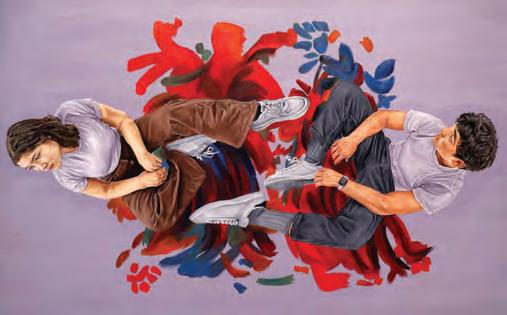
May 9-June 4, 2023
This annual exhibit features the creative works of current Exeter students enrolled in advanced studio courses.

20 Main Street
Exeter, NH 03833-2460
Parents of Alumni: If this magazine is addressed to an Exonian who no longer maintains a permanent address at your home, please email us (records@exeter.edu) with their new address. Thank you.
Jackie Addo ’25 and Kendra Wang ’25 are one of several cross-dorm pairings in Exeter’s newest dormitory, New Hall.